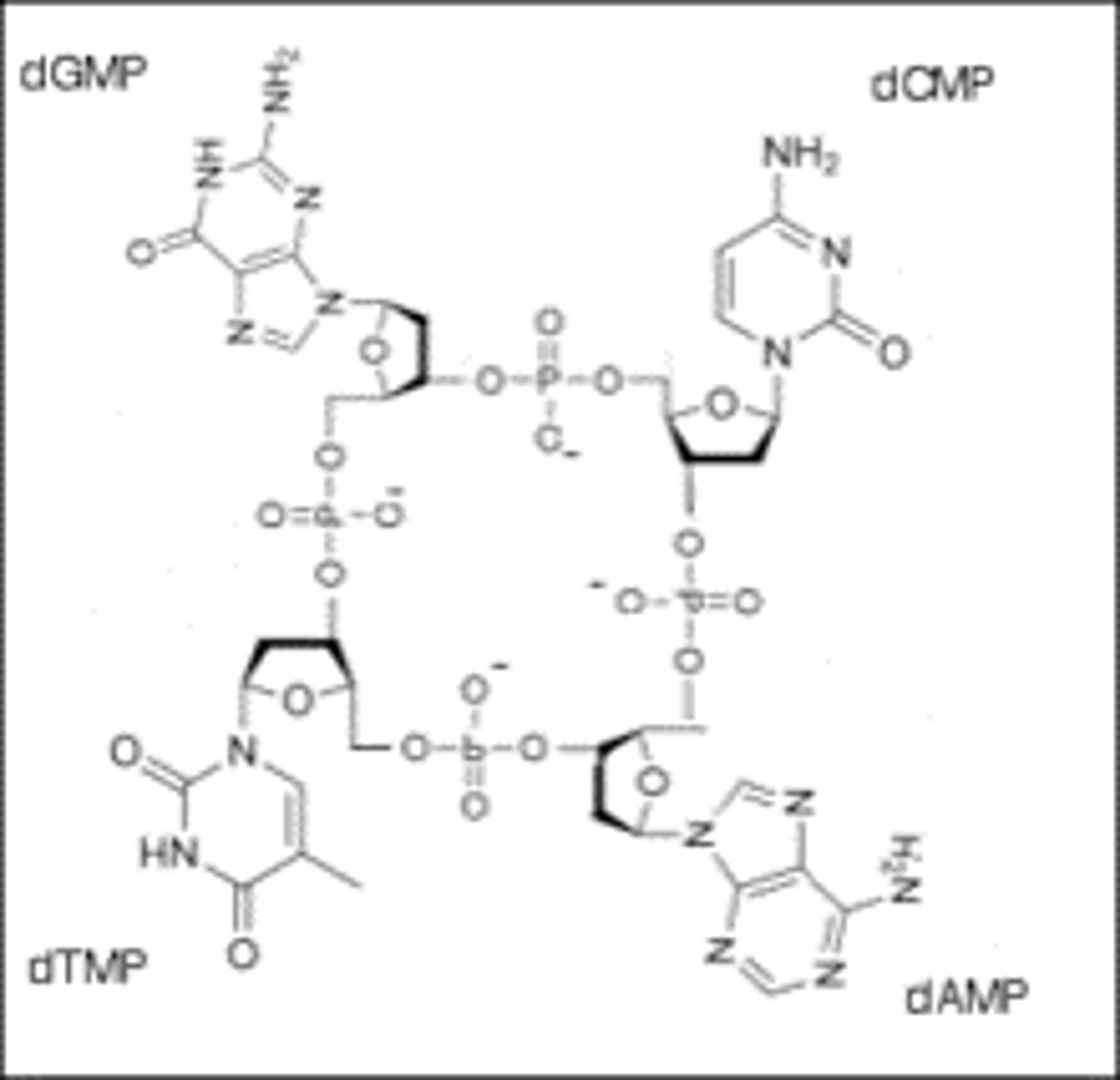Cartões: IB Bio A1.2 Nucleic Acids | Quizlet
1/36
There's no tags or description
Looks like no tags are added yet.
Name | Mastery | Learn | Test | Matching | Spaced |
|---|
No study sessions yet.
37 Terms
State the two primary functions of nucleic acids.
1. Pass genetic information between generations.
2. Code for protein production.

State the two types of nucleic acids used in cells.
A1.2.1— DNA as the genetic material of all living organisms.
DNA: deoxyribonucleic acid
RNA: ribonucleic acid
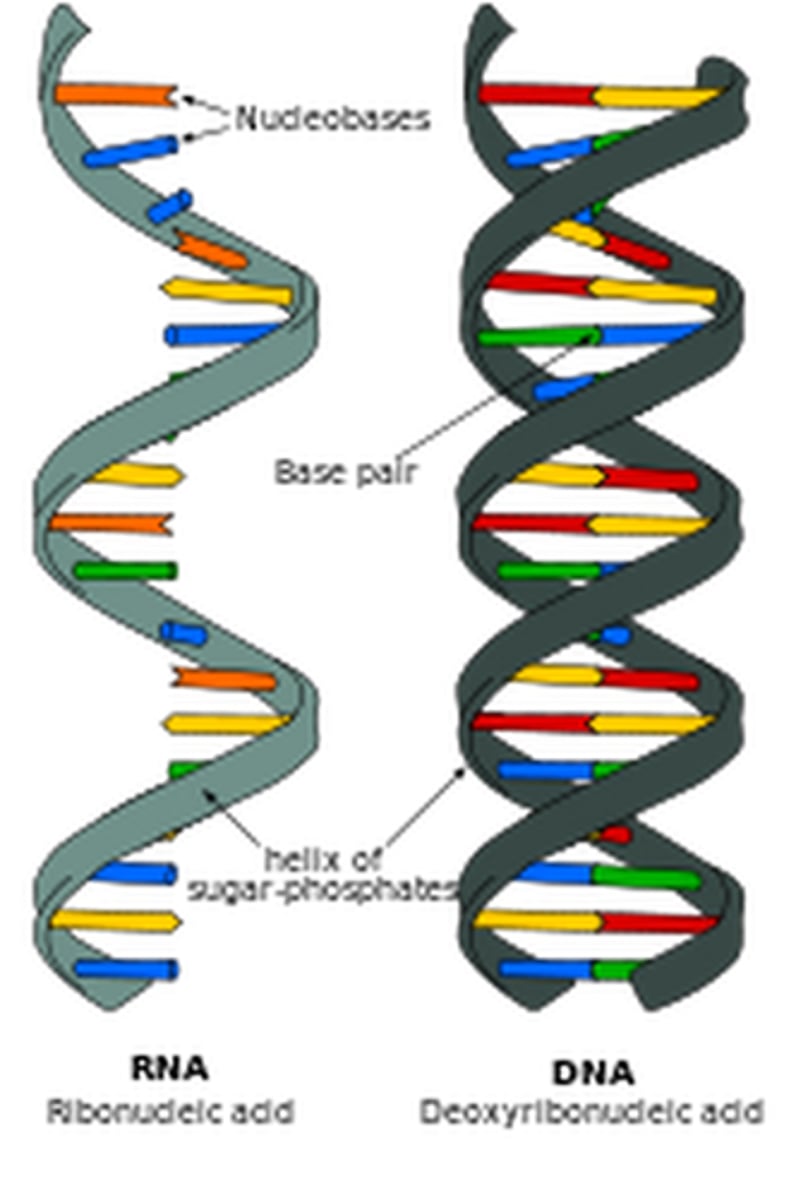
Outline the meaning and implication of DNA being the genetic material of all living organisms.
The meaning is that DNA is the molecule used by all living organisms to code their genetic material.
The implications are:
a) The use of genetic code across all living organisms is evidence of the universal common ancestry of life.
b) A close analysis of the DNA sequence of organisms can be used to assess their evolutionary closeness. The more similar the base sequence, the more closely related the organisms.
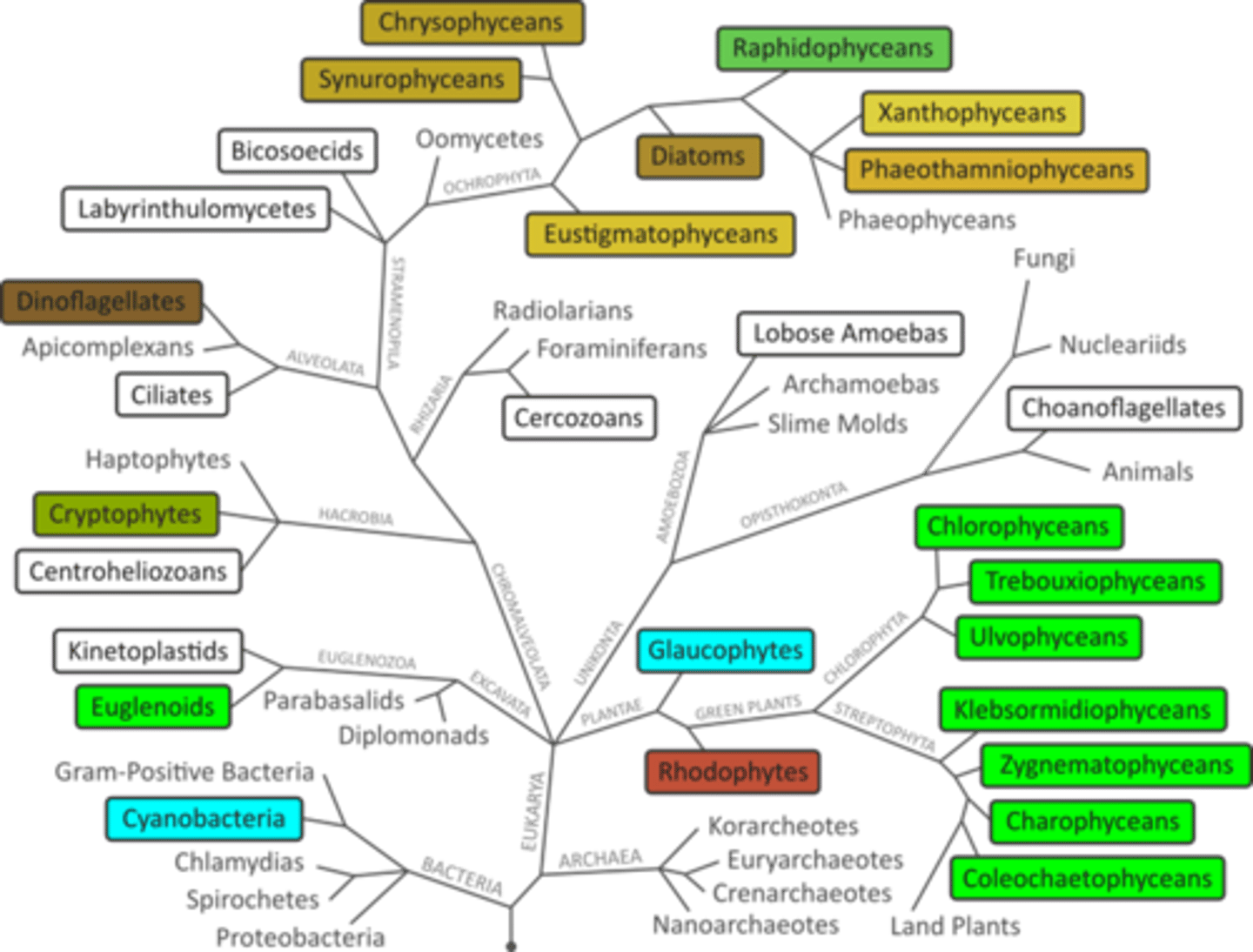
State why RNA viruses do not falsify the claim that all living things use DNA as the genetic material.
Some viruses use RNA as their genetic material. However, because viruses are not made of cells, they are not considered to be living.
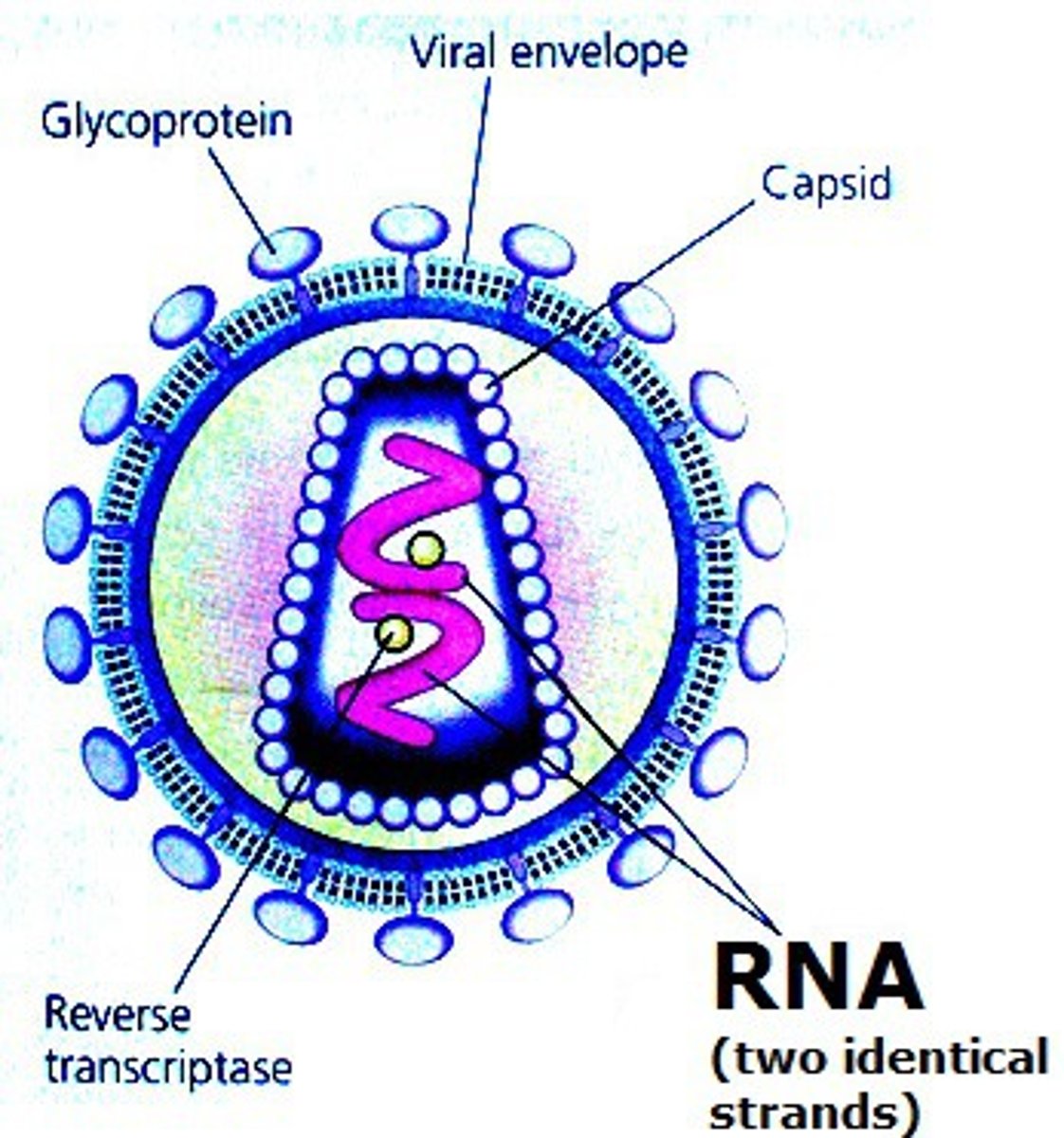
List the three components of a nucleotide.
A1.2.2— Components of a nucleotide.
A nucleotide is the monomer subunit of the nucleic acids. A nucleotide has three component parts:
1. a nitrogenous base
2. A 5-carbon "pentose: sugar (ribose or deoxyribose)
3. A phosphate group

Identify and label the carbons of a pentose sugar.
A1.2.2— Components of a nucleotide.
The carbons of the sugar component of the nucleotide are numbers clockwise, starting from the oxygen in the ring at the top and the phosphate group to the left.
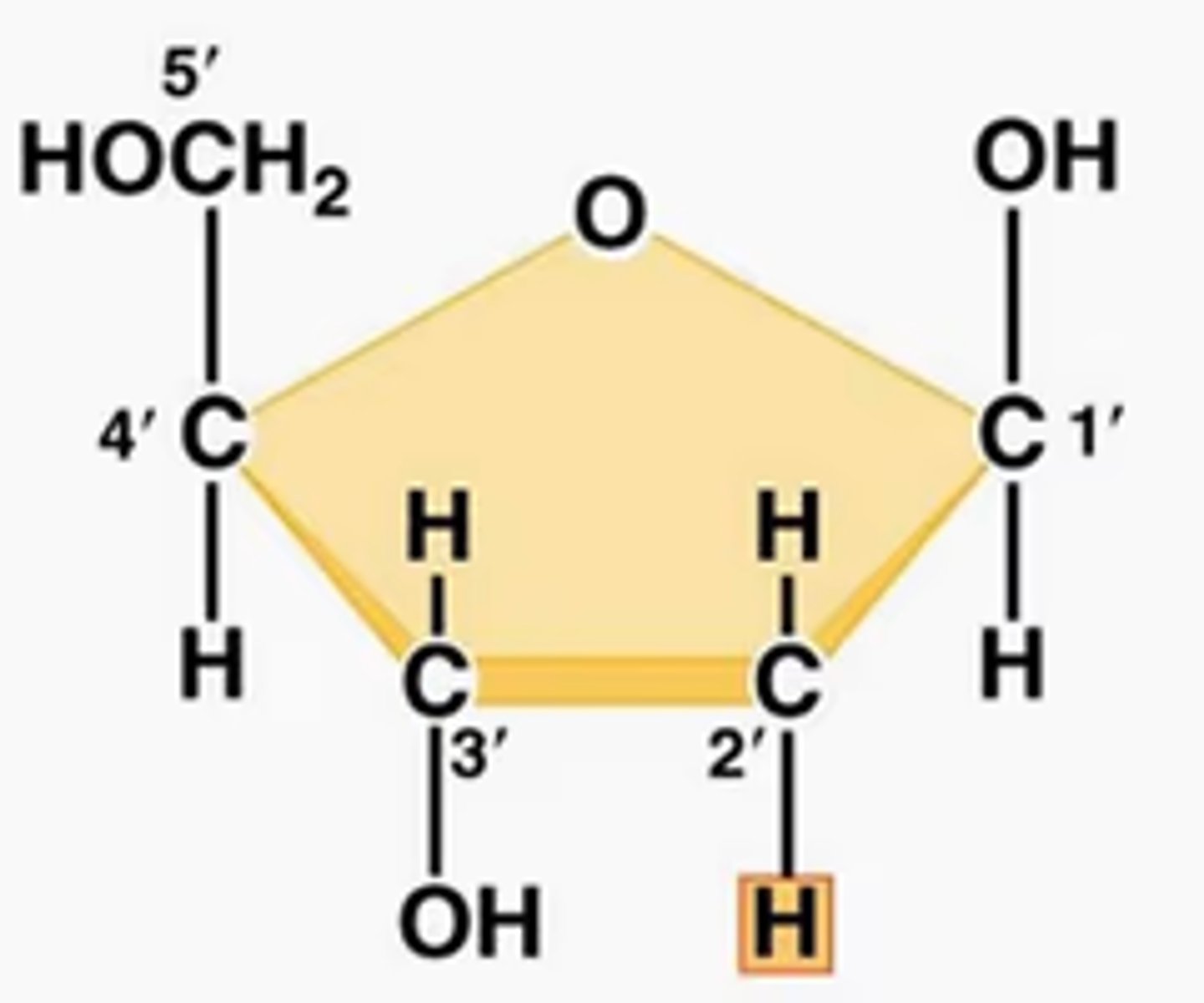
Define “backbone” as related to nucleic acid structure and its importance to the function of the polymers
"Backbone" refers to the alternating "phosphate-sugar; phosphate-sugar" found in nucleic acid polymers, which guarantees the relative strength of the backbone, because of the covalent bonds that link together the phosphate and the 5' carbon, maintaining the nucleotides in their specific sequence.
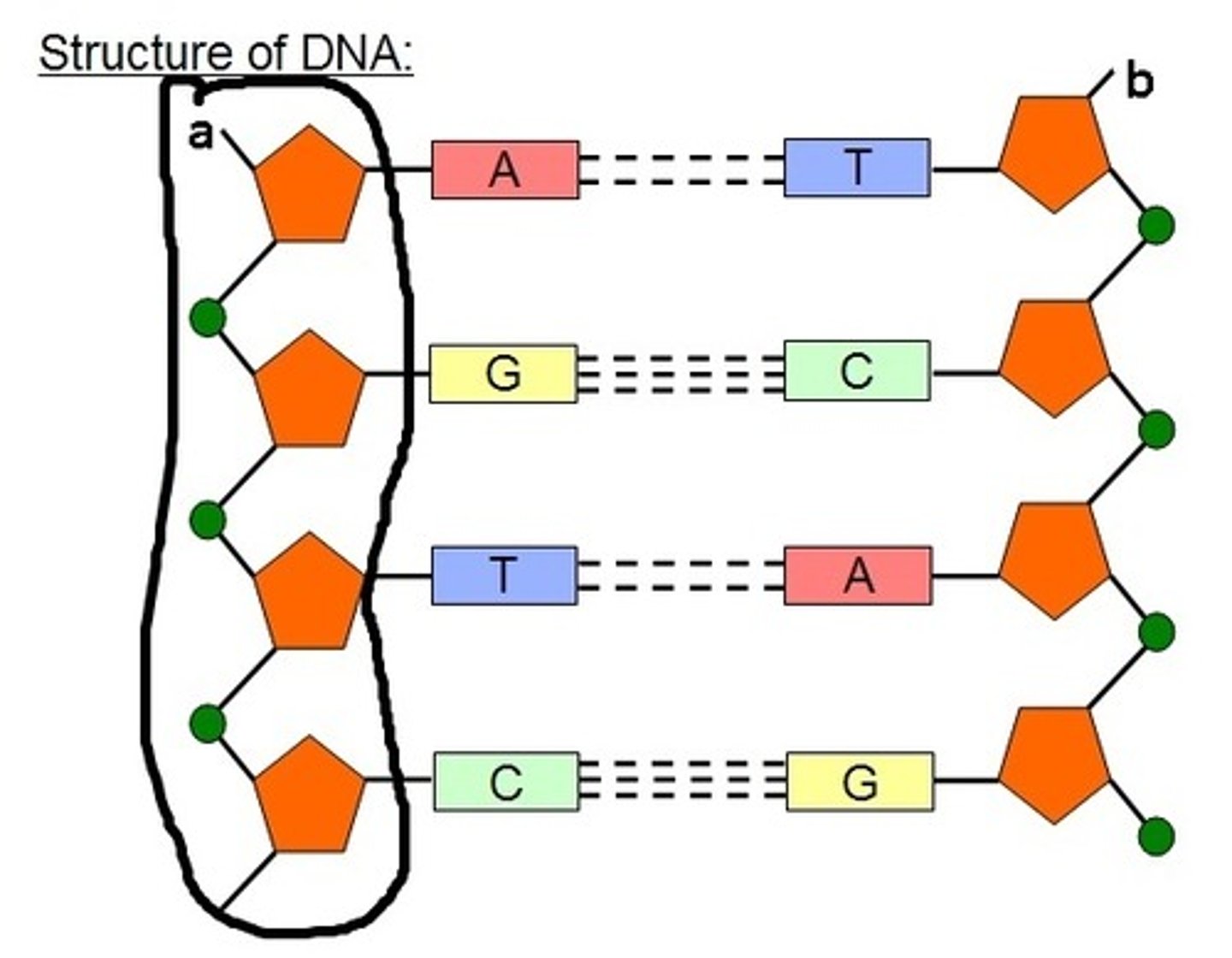
Describe the process by which nucleotides bond together, including the specific functional groups involved and the by-product of this reaction.
Nucleotides connect by creating covalent bonds between the sugar of one nucleotide and the phosphate group of another nucleotide in a condensation reaction.
The 5’ phosphate group on one nucleotide forms a new covalent bond with the 3' carbon on the pentose of the next nucleotide. Water is created as a by-product.
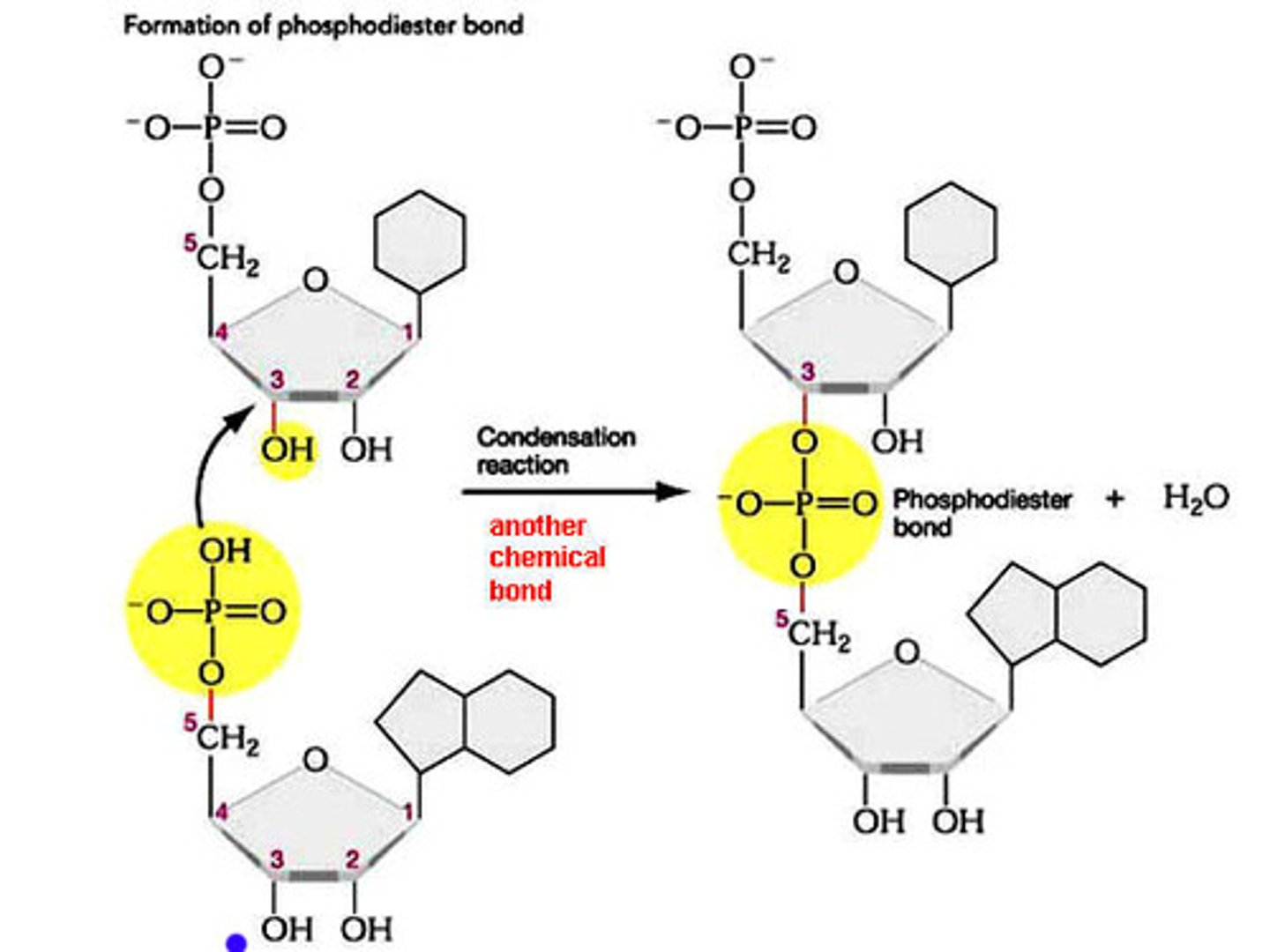
State the names of the nitrogenous bases found in DNA and RNA.
DNA:
Purines: Adenine and Guanine
Pyrimidines: Thymine and Cytosine
RNA:
Purines: Adenine and Guanine
Pyrimidines: Uracil and Cytosine
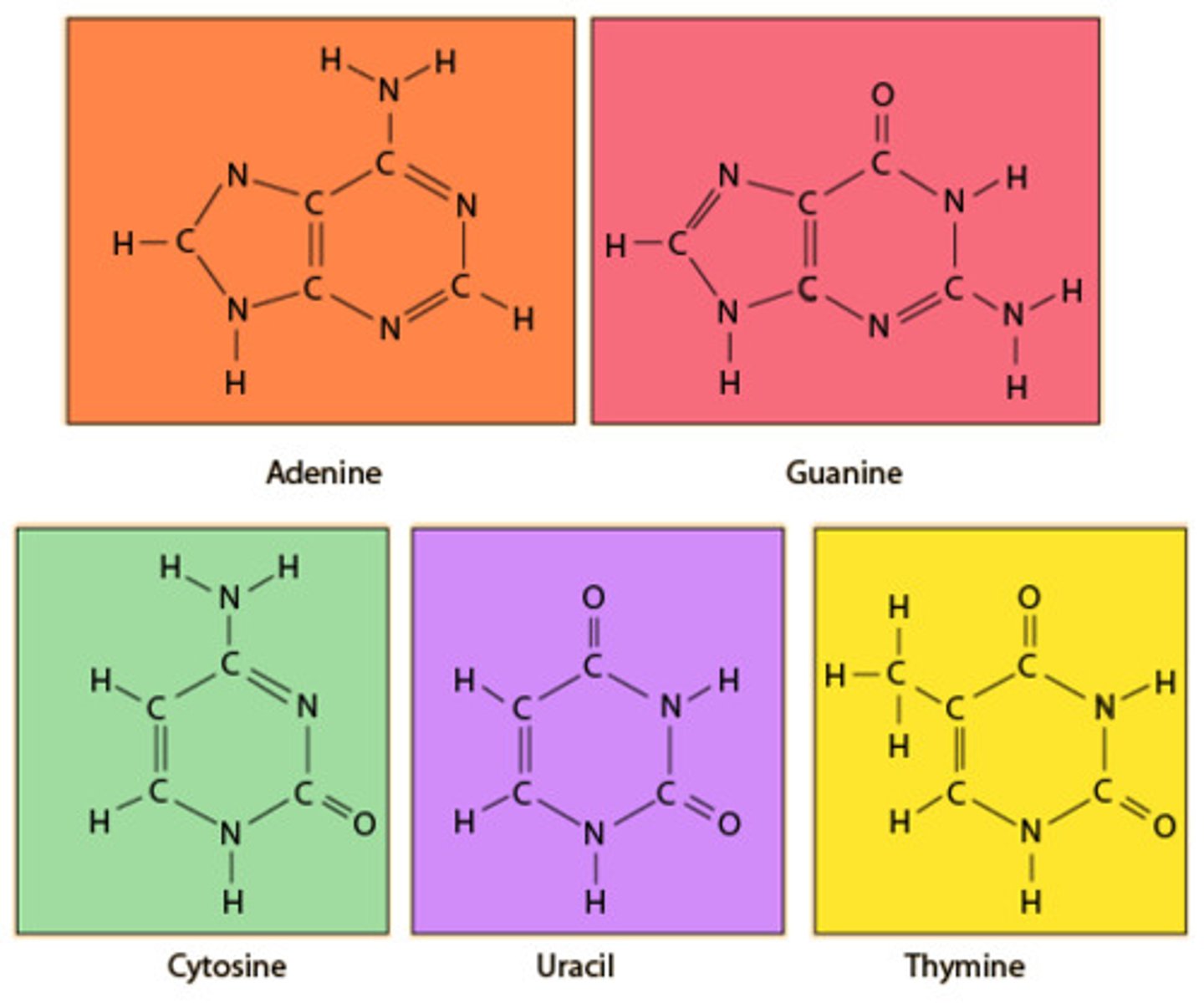
Outline how the sequence of bases in DNA functions as a genetic code, including the role of codons and the relationship between genes and proteins.
The sequence of DNA bases (A, T, C, G) acts as a code by grouping into three-base sequences (codons). Each codon either:
Specifies an amino acid
Signals start/stop for protein building.
A gene is a specific sequence of DNA nucleotides that contains instructions that code for the production of a specific protein.
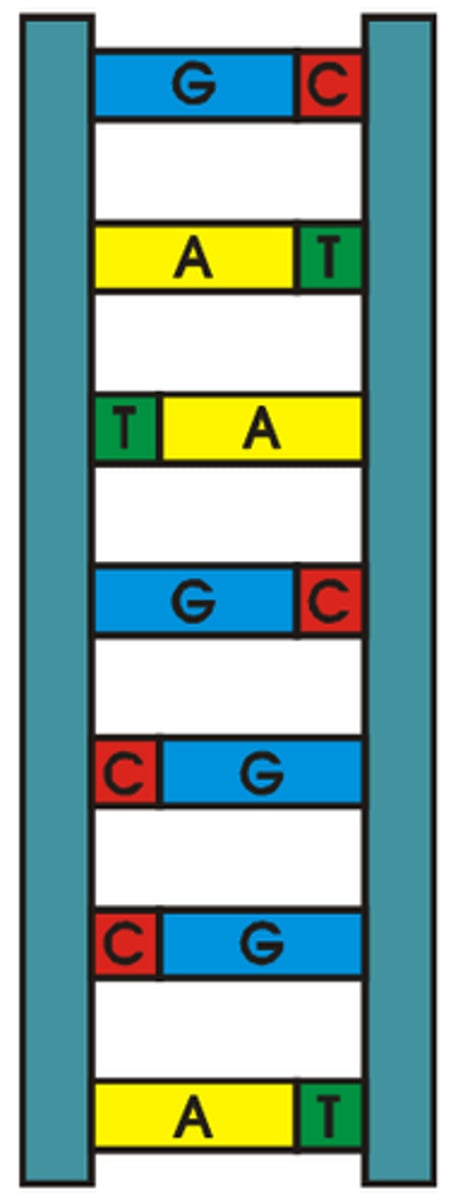
Define gene.
A gene is a specific segment of DNA that contains the instructions to build a functional molecule, usually a protein.
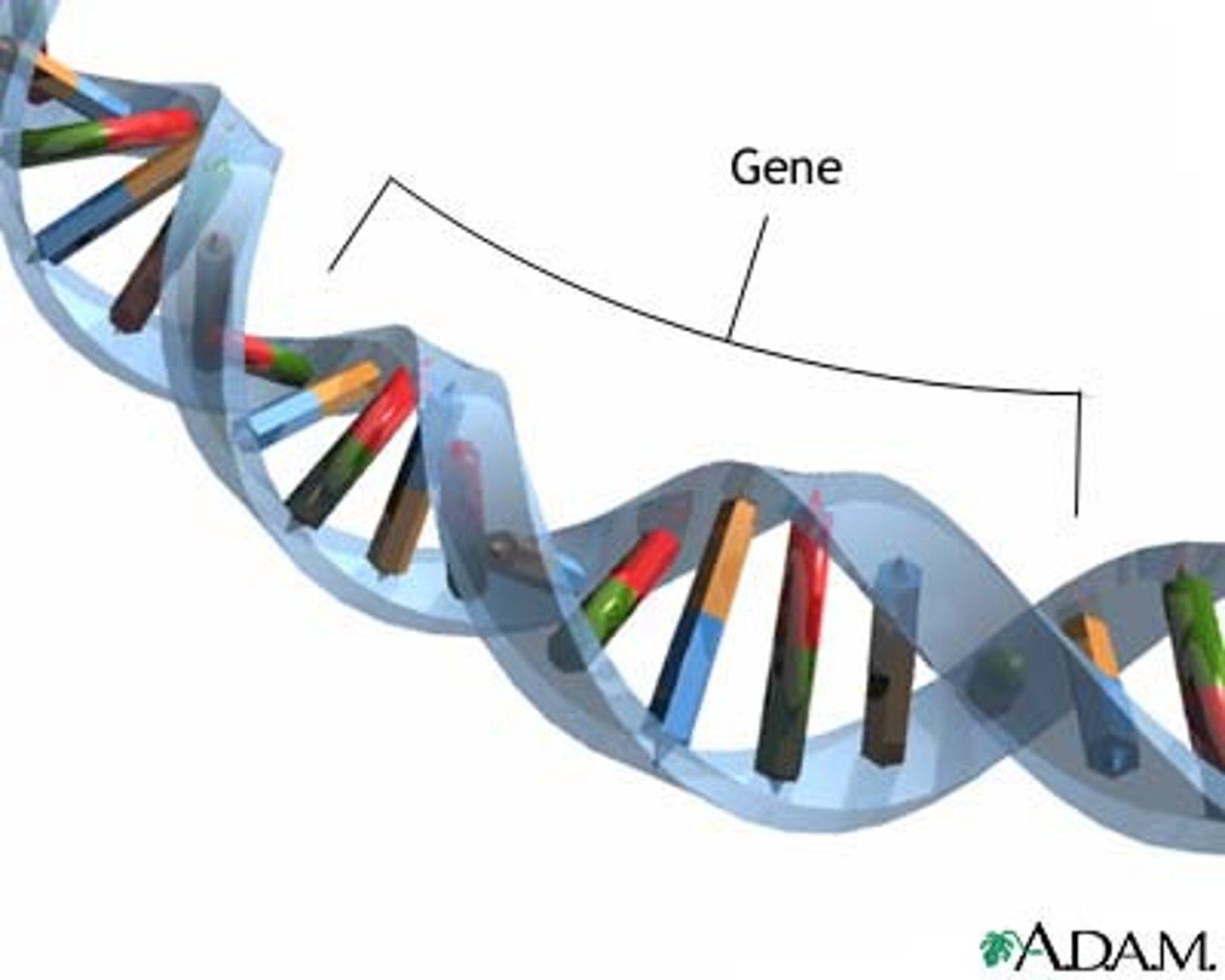
Describe the condensation reaction that forms a polymer of RNA from RNA nucleotides.
RNA nucleotides connect by creating covalent bonds between the ribose sugar of one nucleotide and the phosphate group of another nucleotide in a condensation reaction.
The 5’ phosphate group on one RNA nucleotide forms a new covalent bond with the 3' carbon on the ribose of the next nucleotide. Water is created as a biproduct.
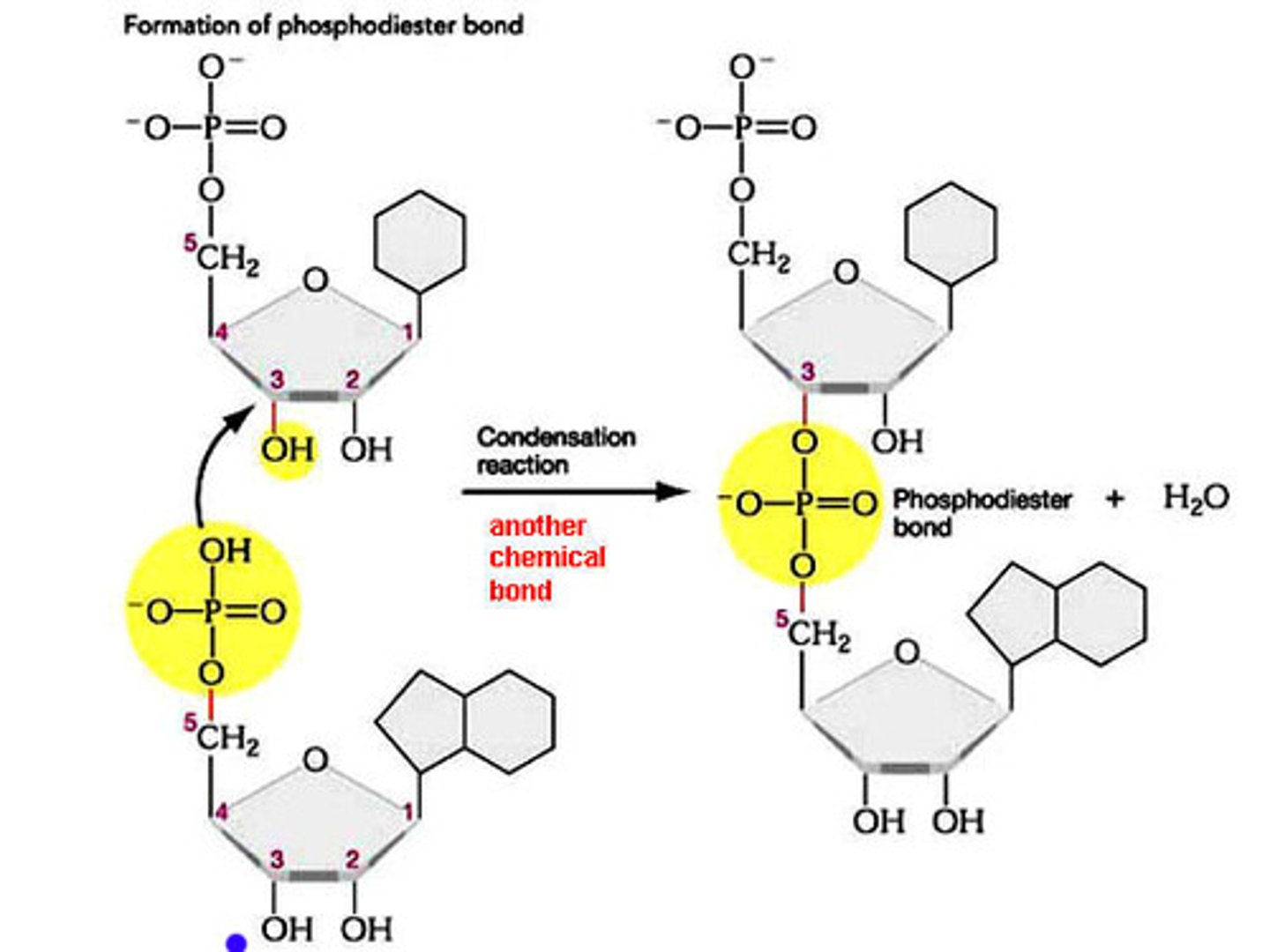
Explain how nucleotides link together to form an RNA polymer, including the specific functional groups that react, the bond created, and the byproduct of this reaction.
An RNA polymer forms when the 3' hydroxyl group (–OH) of one ribose sugar (pentagon) reacts with the 5' phosphate group of another nucleotide, creating a covalent bond (phosphodiester bond) via a condensation reaction (releasing water).
The backbone consists of alternating phosphate and ribose units, with nitrogenous bases (A, U, C, G) attached to each ribose.
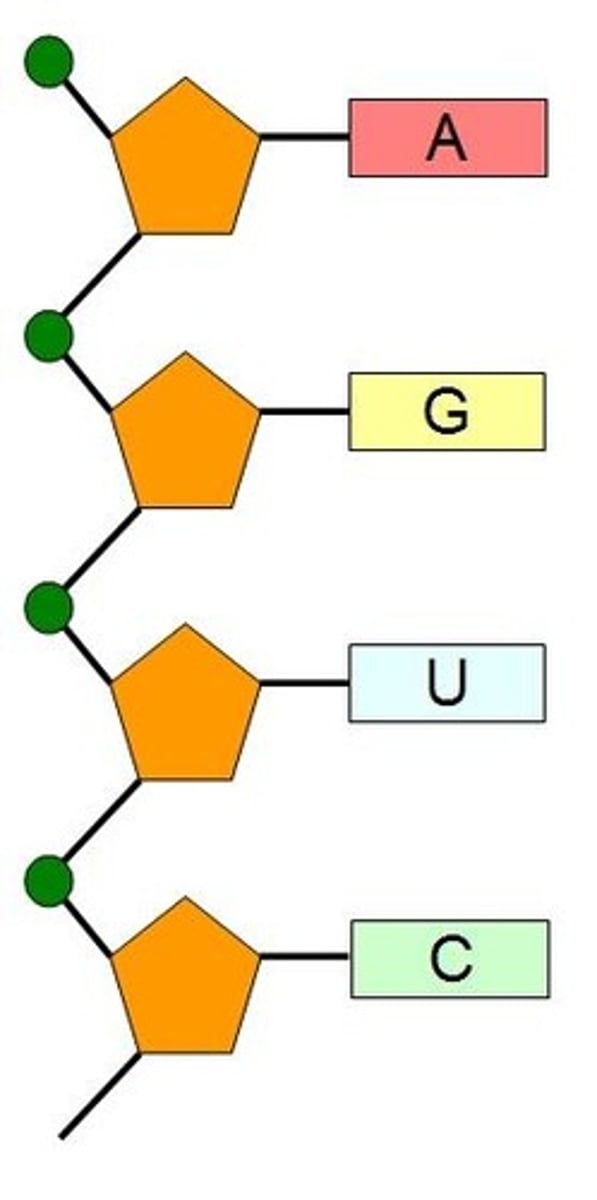
Describe the structure of a DNA double helix, state how they are stabilized and the direction of the bases.
The DNA double helix consists of two antiparallel strands twisted into a right-handed spiral.
Each strand has a sugar-phosphate backbone (deoxyribose + phosphate) linked by covalent bonds called phosphodiester bonds.
The antiparallel strands are held together by hydrogen bonds between complementary nitrogenous bases:
Adenine pairs with Thymine (2 bonds),
Guanine pairs with Cytosine (3 bonds).
The bases stack inward, stabilized by hydrophobic interactions.

Outline the complementary base pairing rule, including the type and number of bonds between bases.
In DNA, the nitrogenous bases of two antiparallel strands form hydrogen bonds with each other. The complementary base pairing rule is that adenine only binds with thymine (with 2 H-bonds) and that guanine only binds with cytosine (with 3 H-bonds).
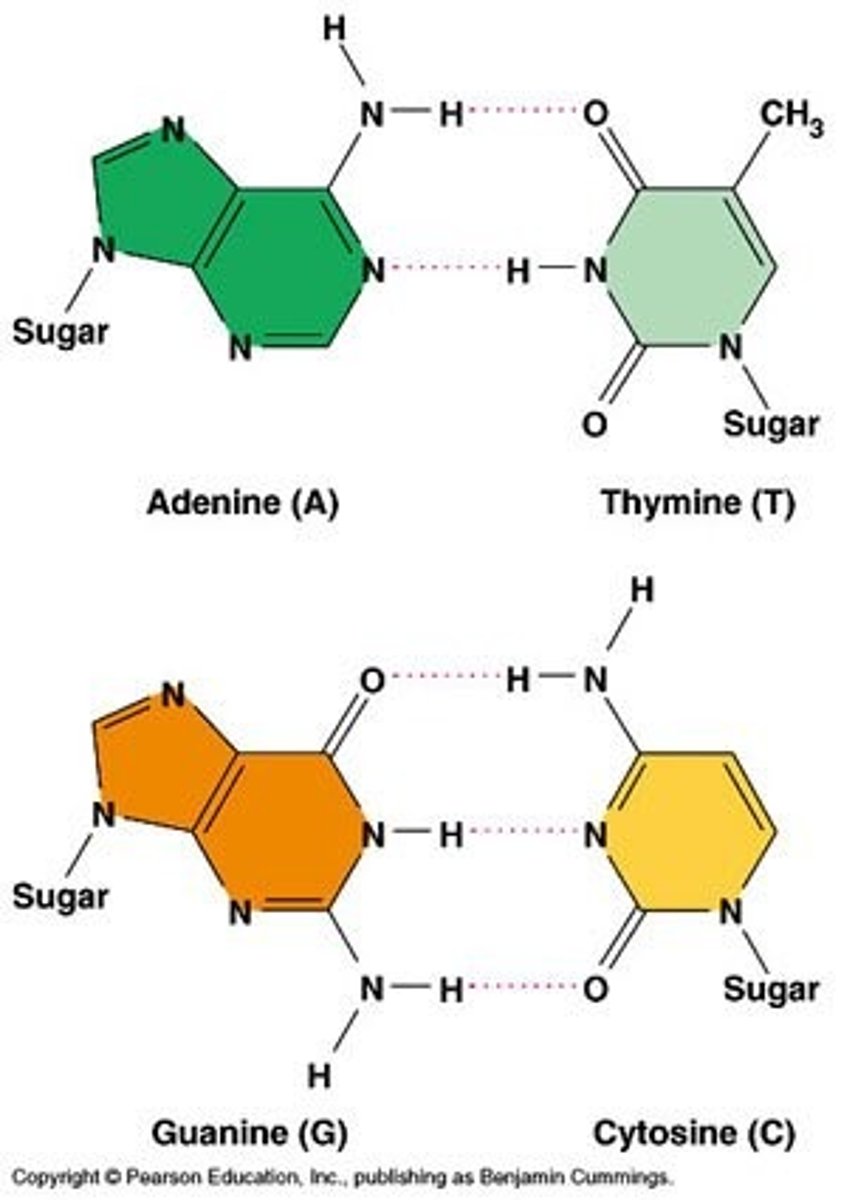
Define antiparallel in relation to DNA structure.
Adjacent molecules are oriented parallel to each other but oriented in opposite directions.
In DNA, one strand runs 5' to 3' and the complementary strand runs 3' to 5'

Compare and contrast (simmilarities and differences) the structure of DNA and RNA.
Both are nucleic acids formed through the condensation of nucleotides. Both DNA and RNA have a sugar-phosphate backbone.
RNA
ribose
single-stranded
nitrogenous bases A, G, C, U
Complementary paring A-U, C-G
DNA
deoxyribose
double-stranded
nitrogenous bases A, G, C, T
Complementary pairing A-T, C-G
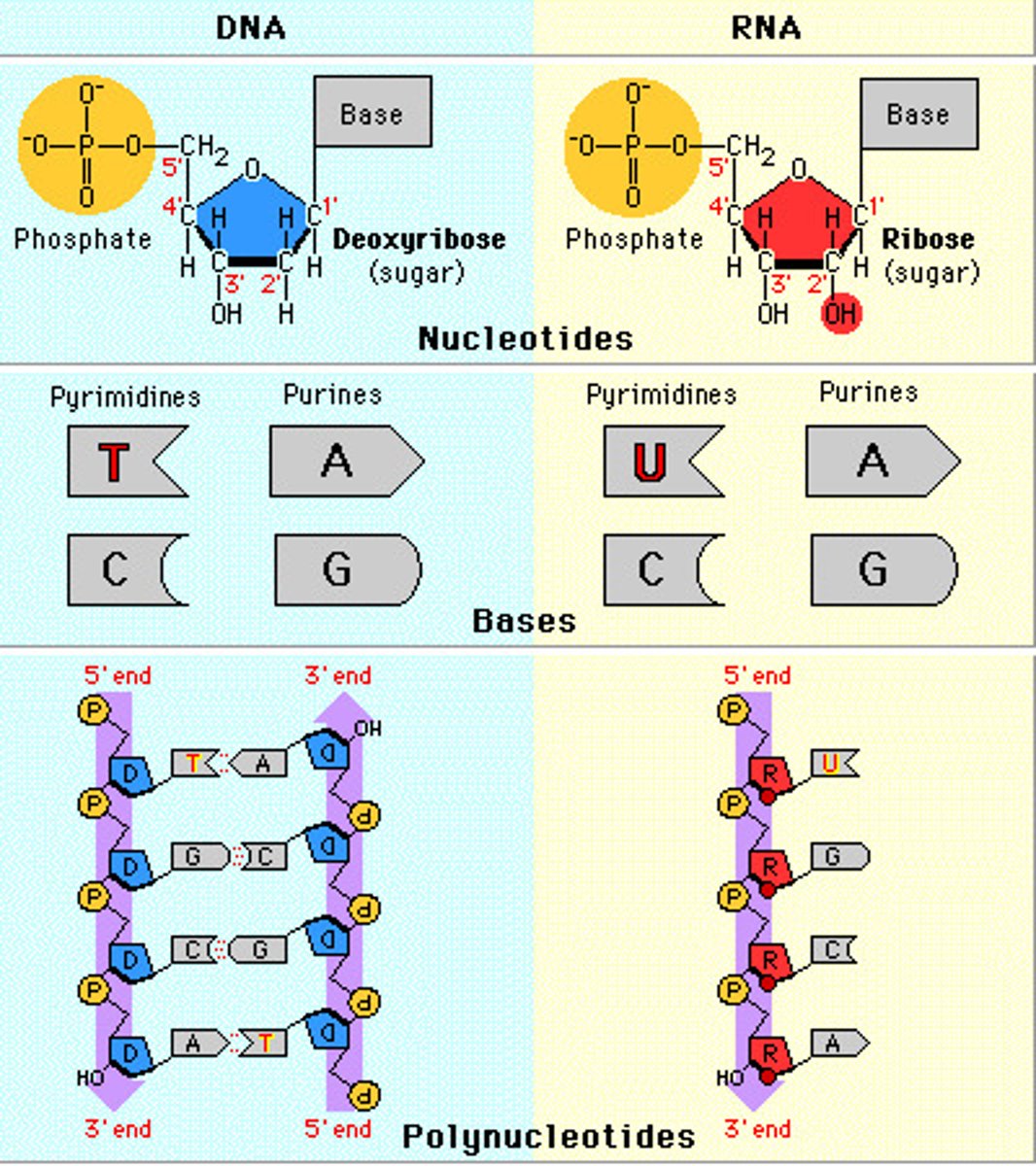
Compare and contrast the functions of DNA and RNA.
DNA:
Passes heredity information between generations of cells
Codes for making RNA during transcription
RNA:
Codes for making proteins during translation
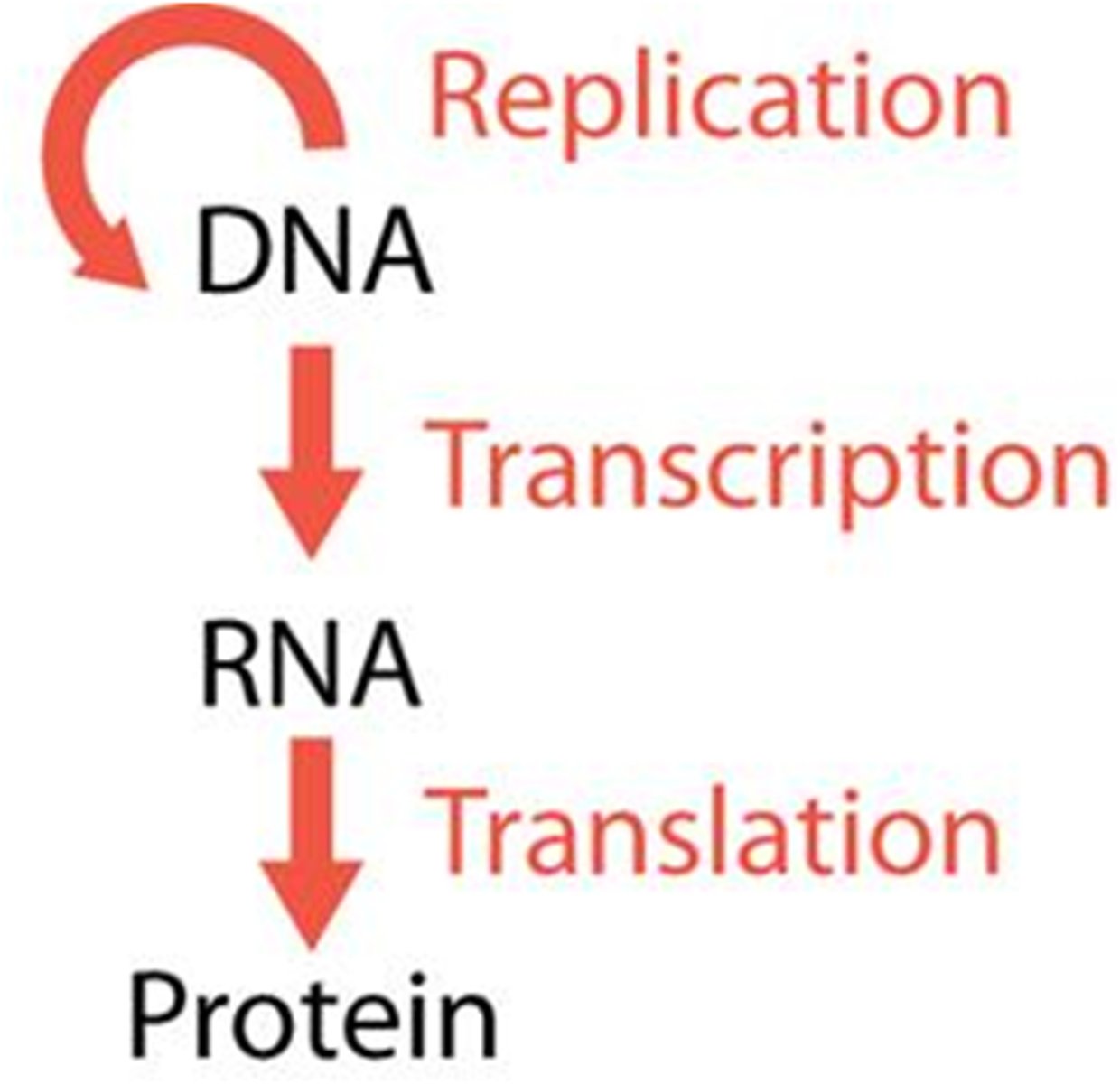
Compare and contrast the location of DNA and RNA in prokaryotic and eukaryotic cells.
A1.2.7— Differences between DNA and RNA.
Eukaryotic Cells
Both DNA and RNA are found in the nucleus.
DNA also in mitochondria and chloroplasts.
RNA also in cytoplasm and as part of ribosomes (free or bound to rough ER)
Prokaryotic Cells
Both DNA and RNA are in the cytoplasm.
DNA is clumped in a region called the nucleoid.
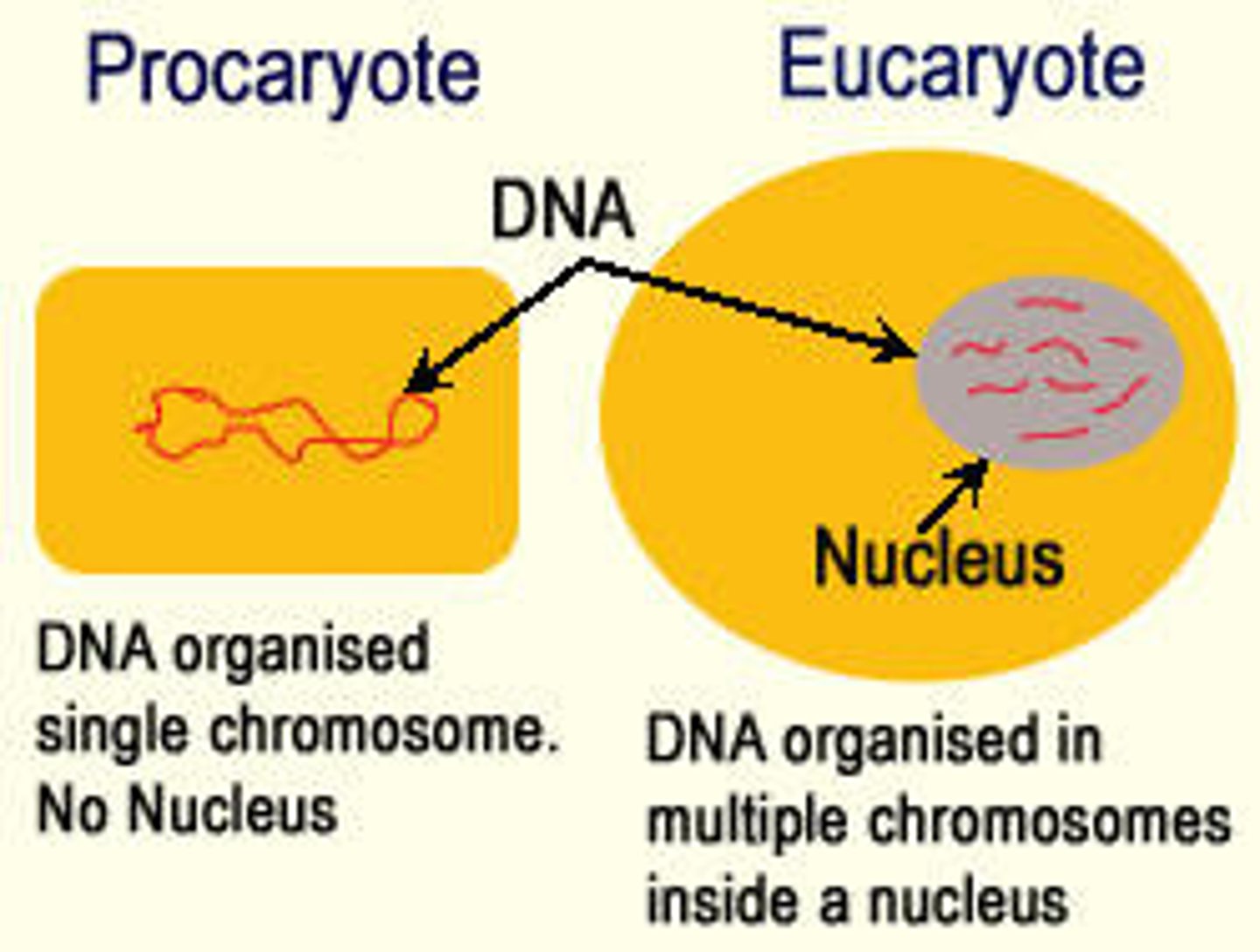
Explain the role of complementary base pairing in maintaining the DNA sequence during DNA replication.
The two strands of a "parent" DNA molecule are broken apart during DNA replication.
Each of these strands serves as a template for creating a new "daughter" strand.
Because of the base pairing rule, the parent template strand will always code for the complementary sequence of nucleotides in the daughter strand (A to T, C to G).
The complementary base pairing will maintain the sequence of the DNA from generation to generation.

Outline the role of complementary base pairing in transmitting the genetic code in transcription.
A1.2.8— Role of complementary base pairing in allowing genetic information to be replicated and expressed.
During transcription, one of the the two strands of a DNA molecule is used as a template for the creation of an RNA strand. Because of the base pairing rule, the DNA template strand will always code for the complementary sequence of RNA nucleotides in the (A to U, C to G). The complementary base paring will maintain the sequence of the gene as mRNA is translated into protein.
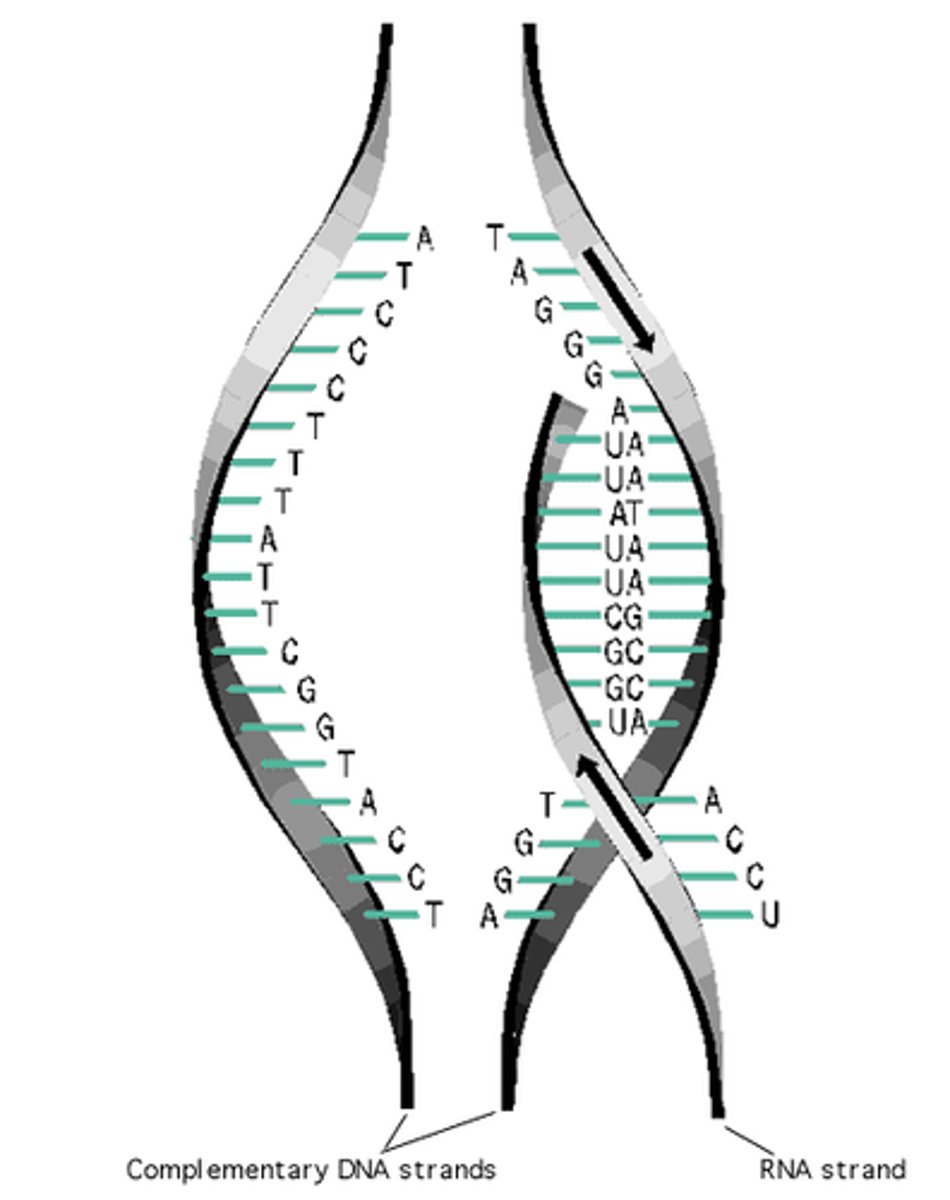
Outline the role of complementary base pairing in transmitting the genetic code in translation.
A1.2.8— Role of complementary base pairing in allowing genetic information to be replicated and expressed.
During translation, an RNA strand is used as a template for the creation of a polypeptide. Because of the base pairing rule, the mRNA codon will only bind with the complementary tRNA anticodon (A to U, C to G). The complementary base paring ensures the correct amino acid are brought in the correct sequence to the ribosome.

Outline why there is a limitless diversity of DNA base sequences.
A1.2.9— Diversity of possible DNA base sequences and the limitless capacity of DNA for storing Information.
There are four nitrogenous bases in DNA (A, T, C and G). These 4 bases are components of nucleotides that can form a DNA molecule in any order and of any length.
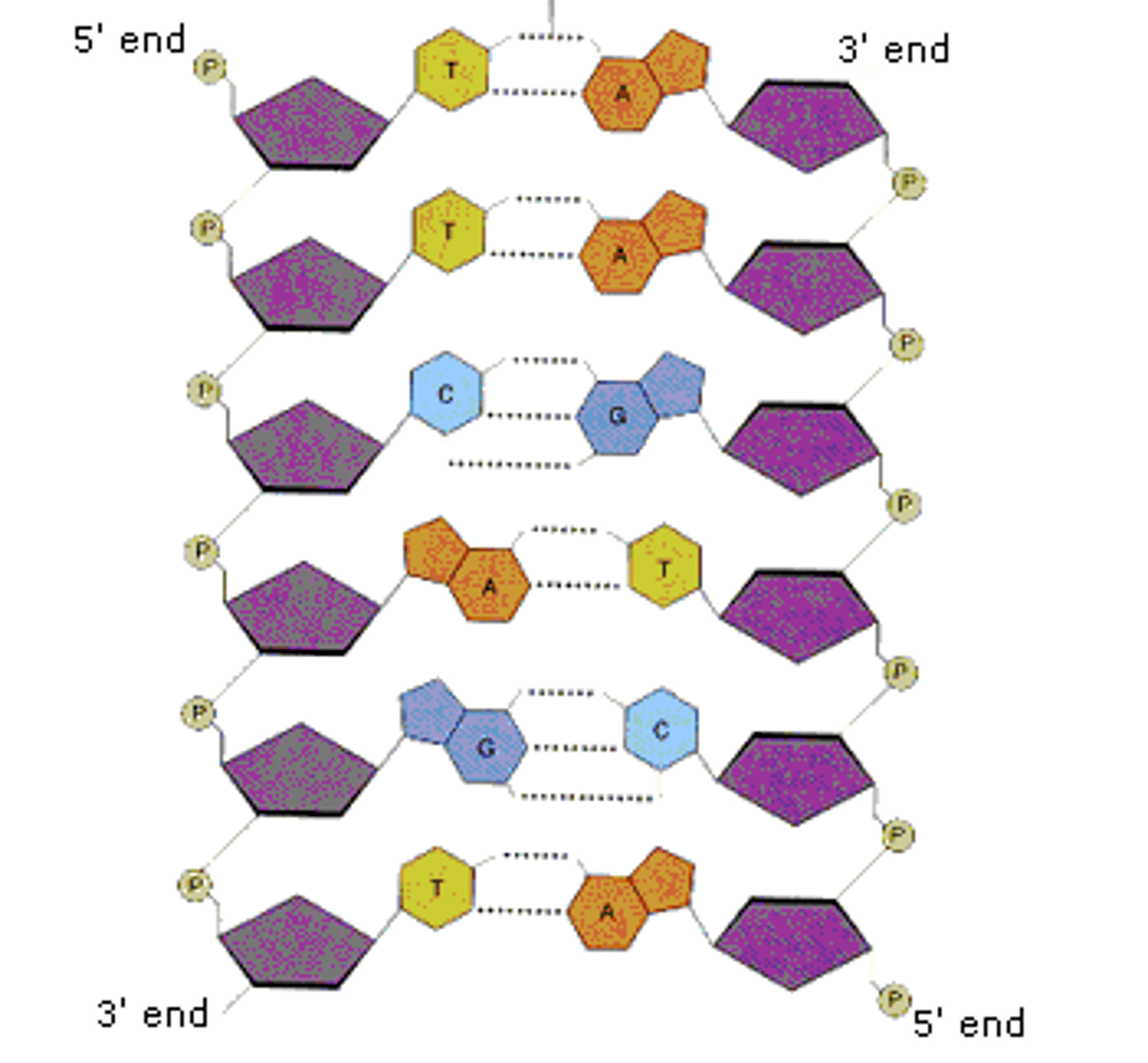
Define universal in relation to the genetic code.
A1.2.10— Conservation of the genetic code across all life forms as evidence of universal common ancestry.
Universal means that the characteristic is shared by all life. A universal generic code means that all life uses essentially the same code when translating information stored in genes into a polypeptide.
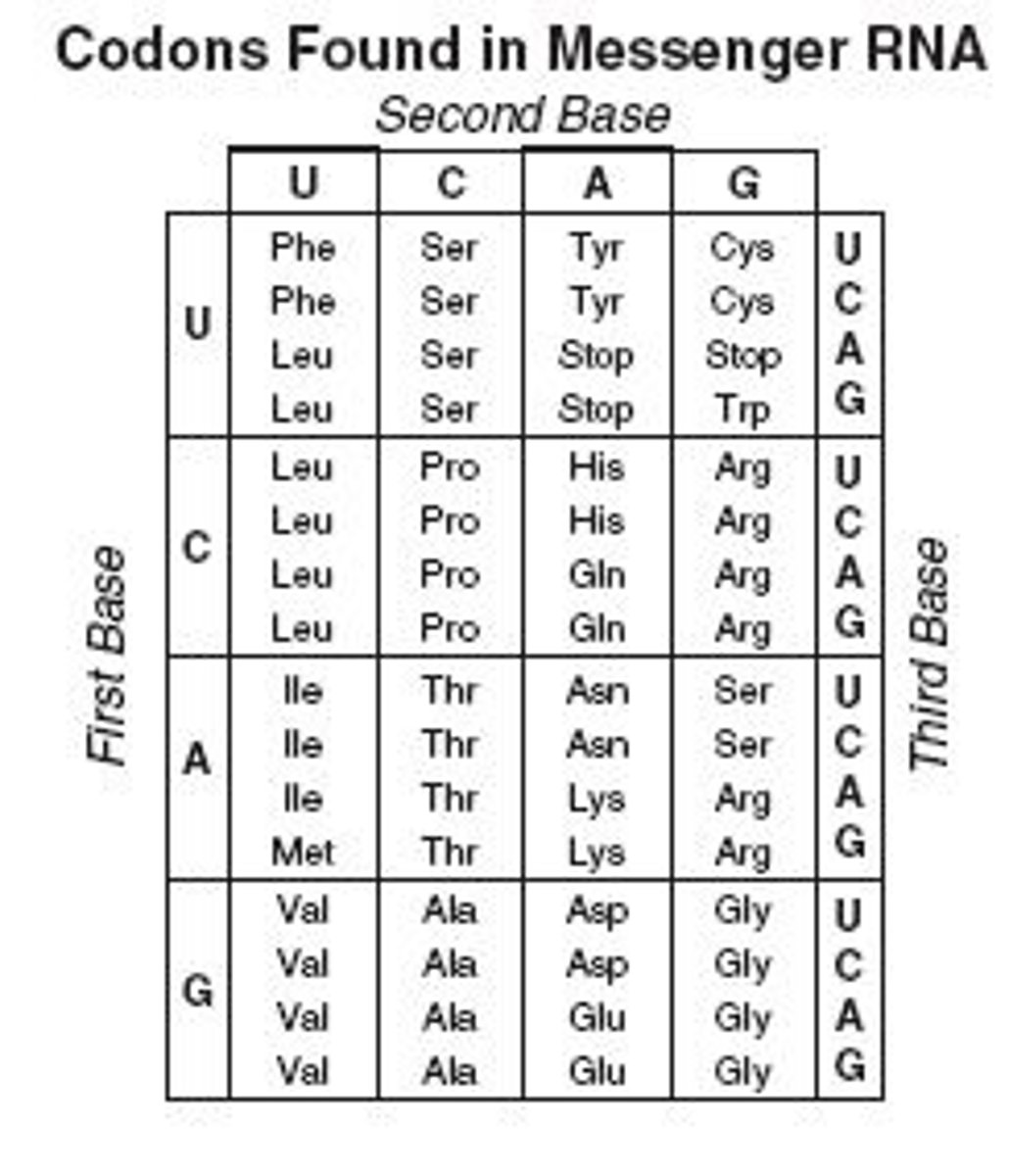
Outline why conservation of the genetic code across all forms of life is evidence of common ancestry.
A1.2.10— Conservation of the genetic code across all life forms as evidence of universal common ancestry.
Using inductive reasoning, it can be concluded that the use of the same genetic code across all forms of life indicates that all organisms inherited the use of the code from a common ancestor. The alternative, that all forms of life independently developed use of the same genetic code, is an illogical hypothesis.
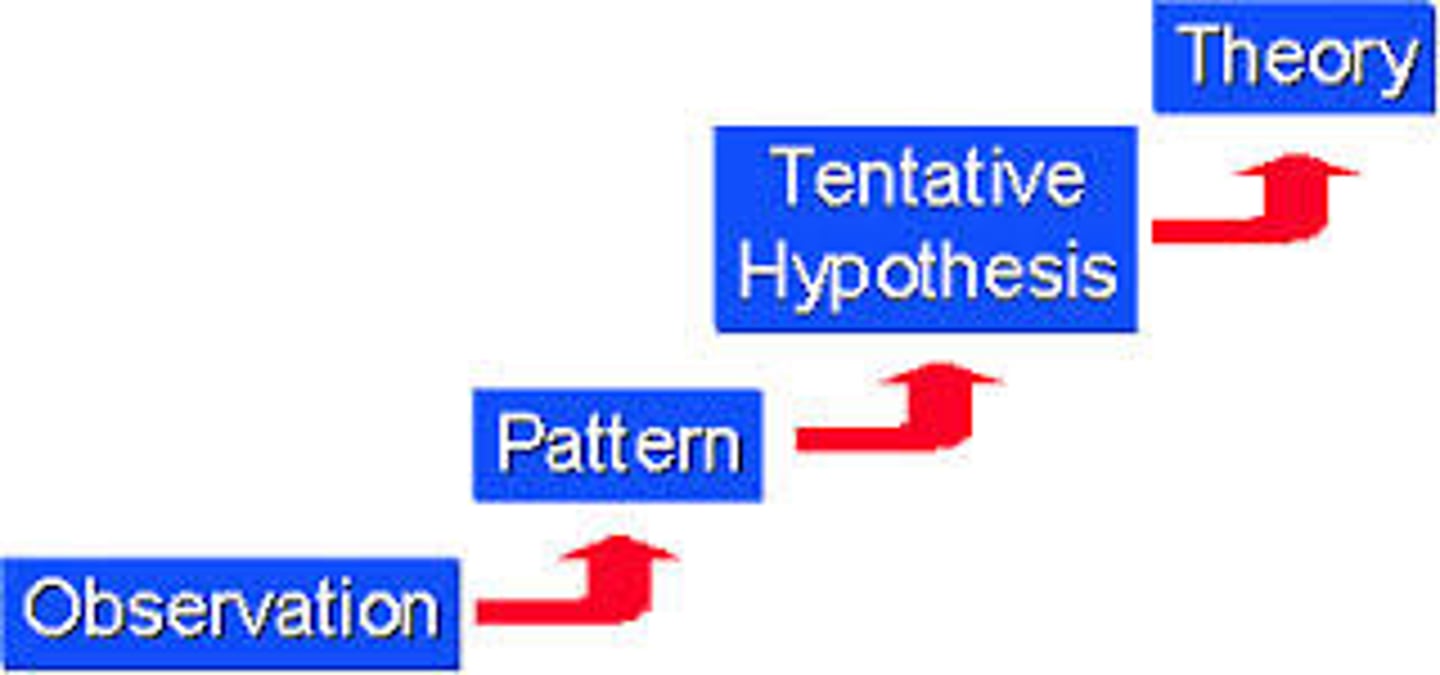
Identify and label the 5’ and 3’ ends on a DNA or RNA diagram.
AHL A1.2.11— Directionality of RNA and DNA.
Each end of DNA nucleotide has a number. One end is referred to as 5' (five prime) and the other end is referred to as 3' (three prime). The 5' and 3' designations refer to the number of the carbon atom in a deoxyribose sugar molecule. The 5' end is identified by the presence of the phosphate group and the 3' end is identified as ending in the pentose sugar (ribose or deoxyribose).
In DNA, one strand will run from 5' to 3' and the complementary strand will run anti-parallel, from 3' to 5'.

Compare and contrast the structures of purines and pyrimidines.
AHL A1.2.12— Purine-to-pyrimidine bonding as a component of DNA helix stability.
Both purines and pyrimidines are nitrogenous bases of DNA and RNA.
Pyrimidine: single ring nitrogenous bases
Cytosine
Thymine
Uracil
Purine: double ring nitrogenous bases
Guanine
Adenine
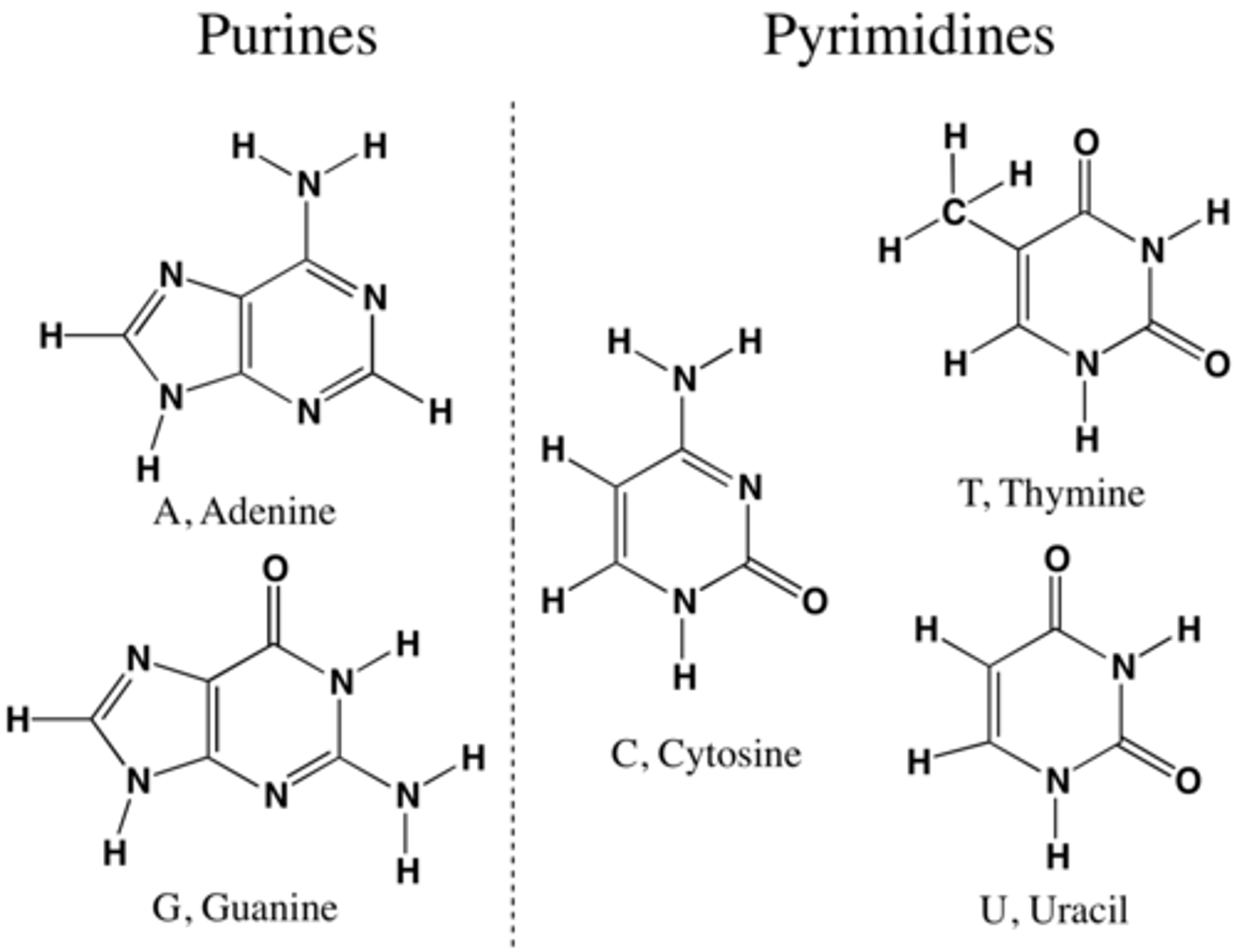
State that in DNA, a purine forms hydrogen bonds with a pyrimidine.
AHL A1.2.12— Purine-to-pyrimidine bonding as a component of DNA helix stability.
In DNA, a purine complementary base pairs to a pyrimidine using hydrogen bonds
In DNA and RNA, guanine bonds with cytosine with three hydrogen bonds.
In DNA, adenine bonds with thymine with two hydrogen bonds.
In RNA, adenine bonds with uracil with two hydrogen bonds
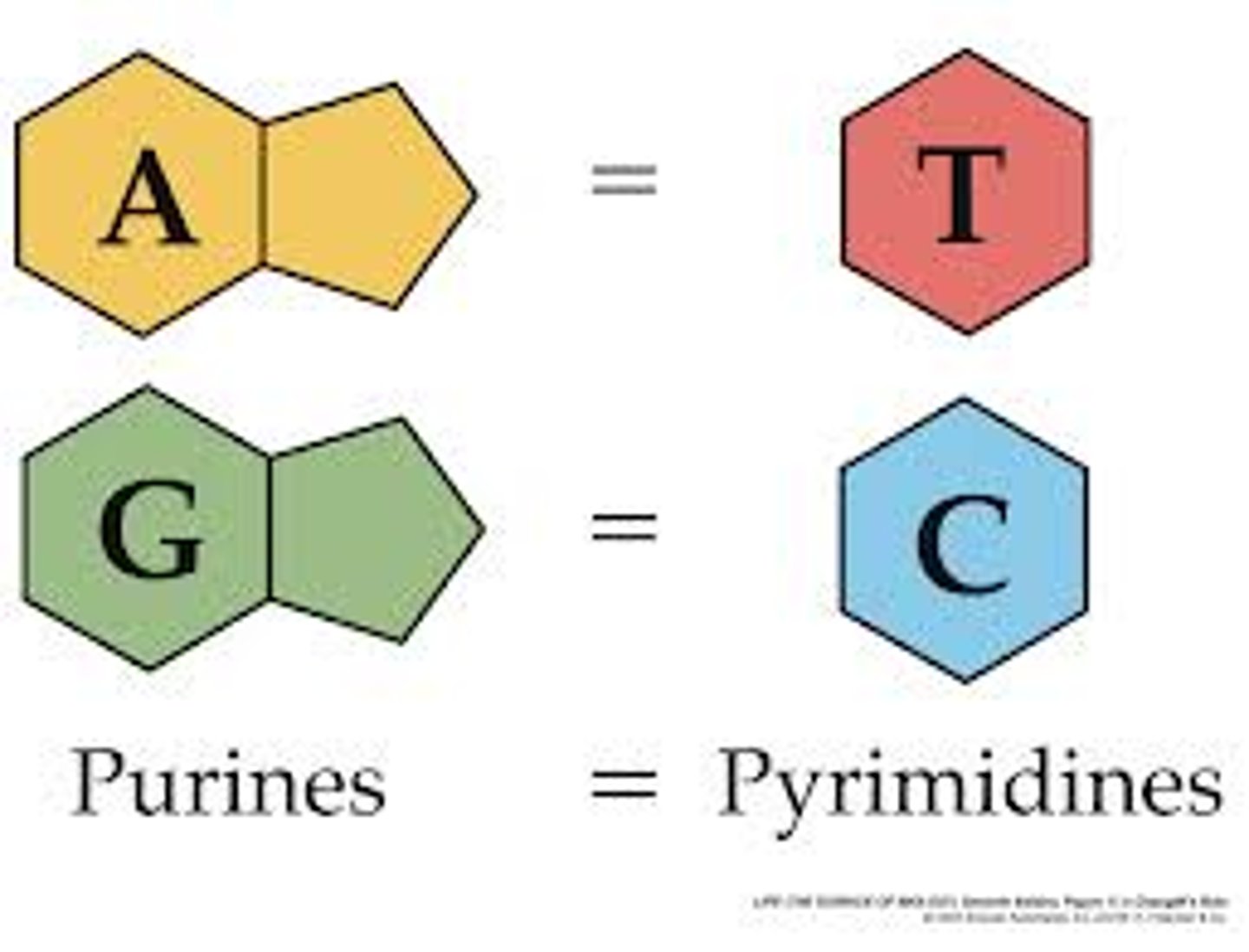
Given a diagram of DNA, identify the four bases of DNA based on purine or pyrimidine and the number of hydrogen bonds.
AHL A1.2.12— Purine-to-pyrimidine bonding as a component of DNA helix stability.
Purines have two rings. If it can form 2 H-bonds it is adenine and if it can form 3 H-bonds it is guanine.
Pyrimidines have one ring. If it can form 2 H-bonds it is thymine and if it can form 3 H-bonds it is cytosine.
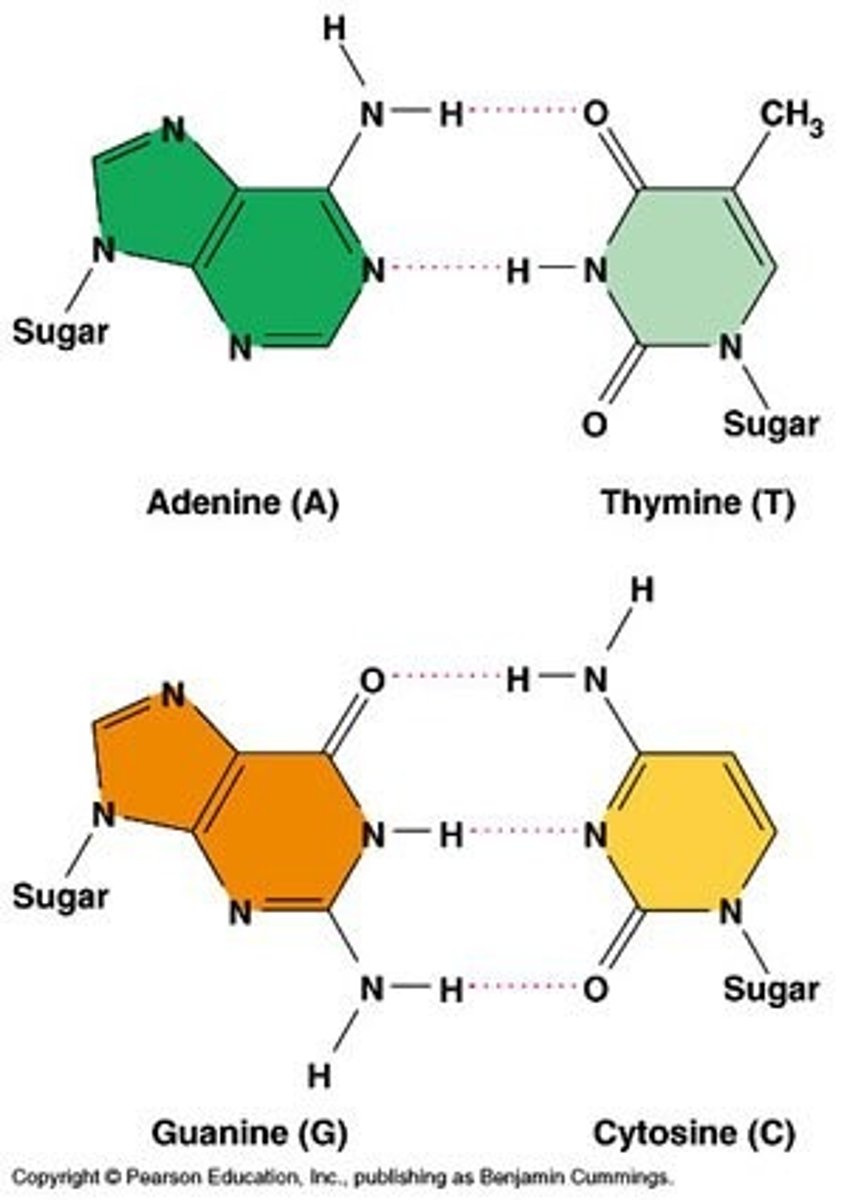
Describe the structure of eukaryotic DNA and associated histone proteins during interphase (chromatin).
AHL A1.2.13— Structure of a nucleosome.
To compact DNA while regulating gene accessibility for transcription, eukaryotic organisms organize their genomes:
1. DNA double helix.
2. DNA wraps around histone proteins, forming nucleosomes and the "beads on a string" structure.
3. Multiple nucleosomes wrap into a fibre (chromatin).
4. Supercoiling of the chromatin produces the chromosome (during mitosis and meiosis). Supercoiling refers to the repeated twisting and winding of the DNA strand. Supercoiling functions to reduce the space required for DNA packaging, allowing for more compact storage of DNA.
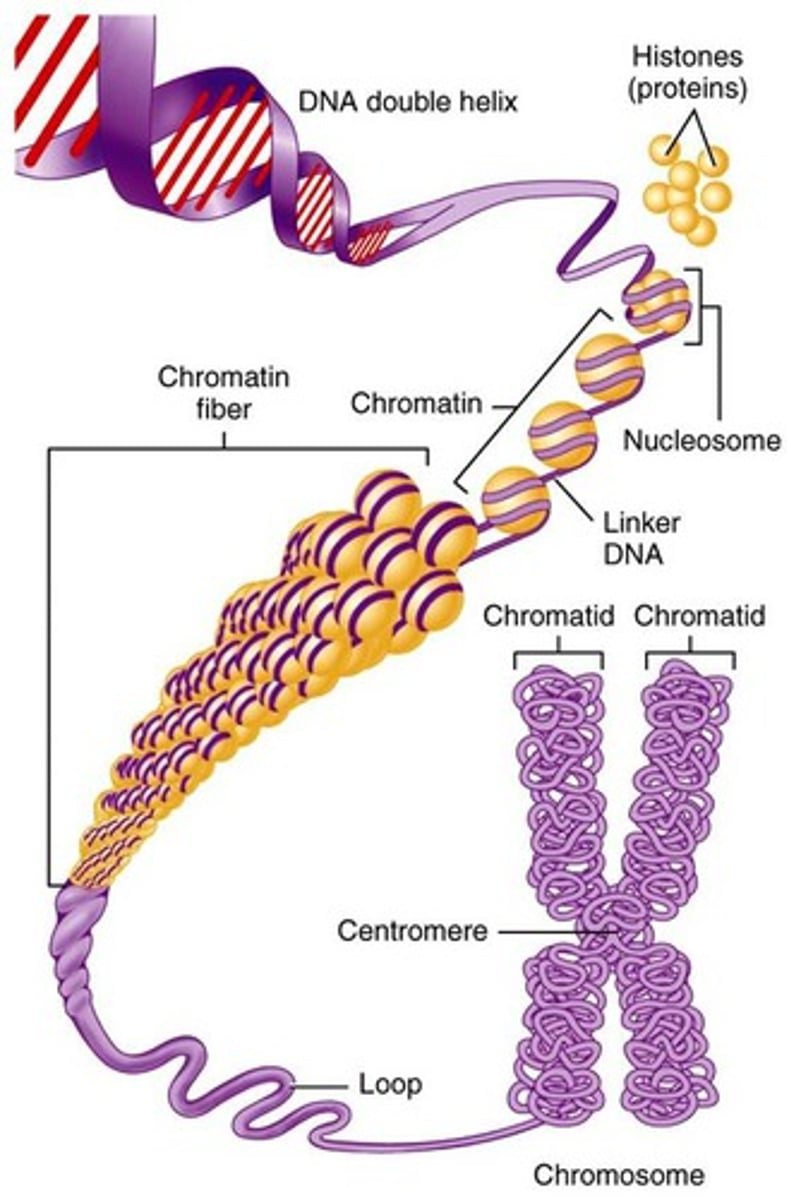
Draw and label the structure of a nucleosome, including the H1 protein, the octamer core proteins, linker DNA and two wraps of DNA.
AHL A1.2.13— Structure of a nucleosome.
The nucleosome is the basic unit of DNA packaging in eukaryotes. Each nucleosome is composed of two turns of DNA wrapped around a group of eight histone proteins (called an octamer core). Each nucleosome connects to the adjacent nucleosomes through another type of histone protein (called the H1) and a region of "linker" DNA.
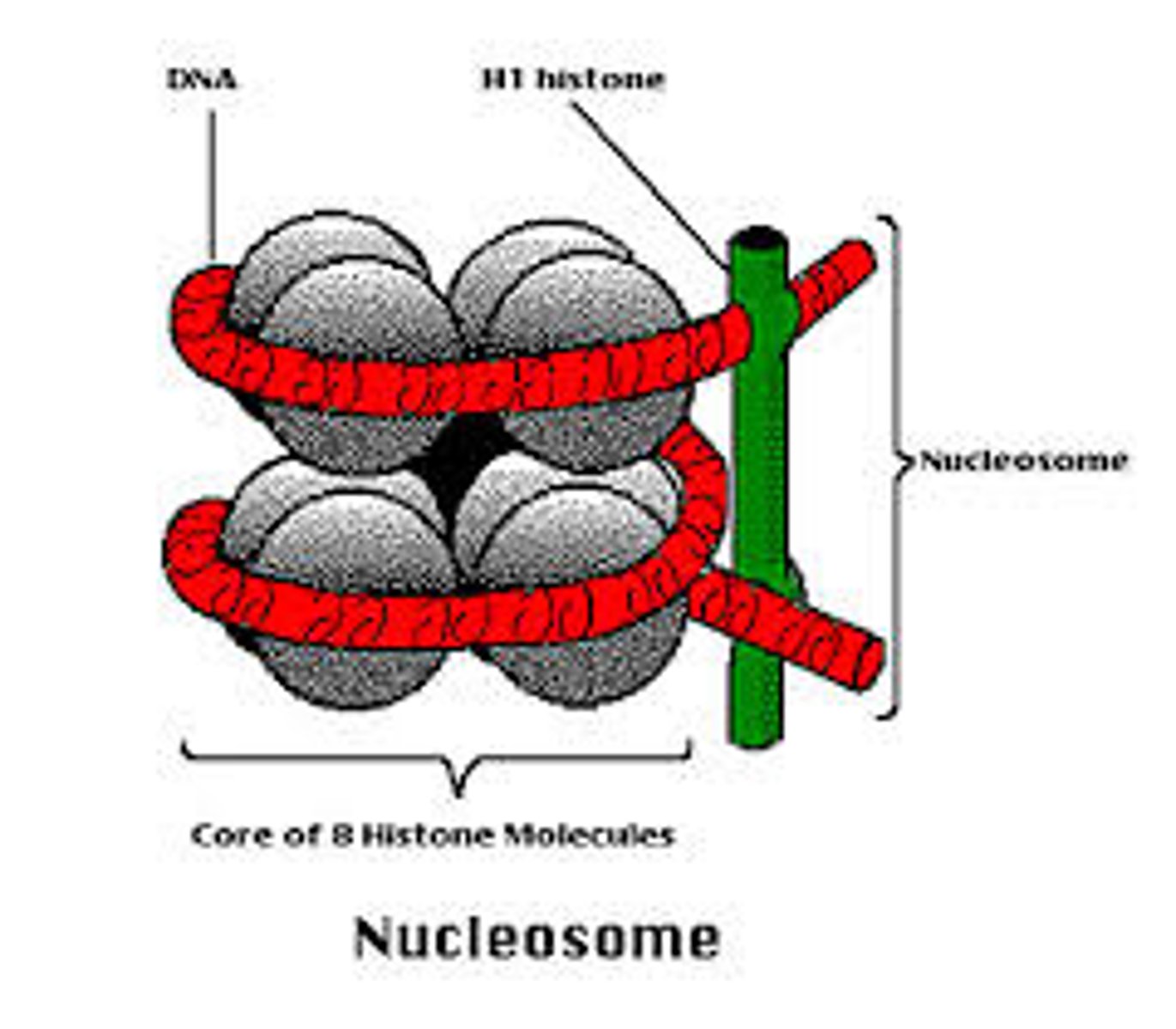
State the experimental question being tested in the Hershey and Chase experiment.
AHL A1.2.14— Evidence from the Hershey–Chase experiment for DNA as the genetic material.
Both protein and nucleic acids are part of the eukaryotic cell nucleus, and prior to 1952 it was unknown which molecule type was responsible for passing genetic information between generations. Hershey and Chase designed an experiment to test whether proteins or DNA is the hereditary material.
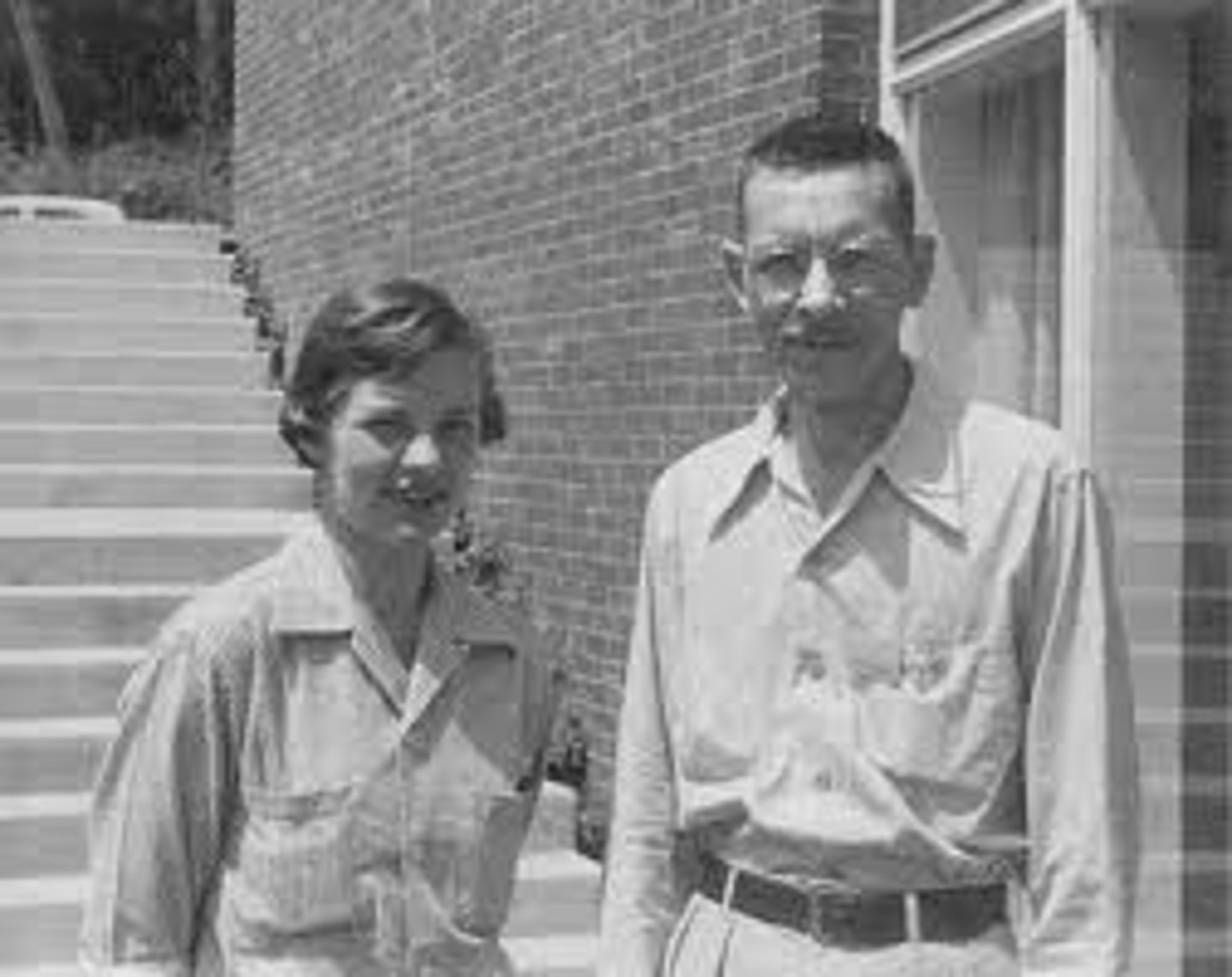
Outline the procedure of the Hershey and Chase experiment.
AHL A1.2.14— Evidence from the Hershey–Chase experiment for DNA as the genetic material.
Hershey and Chase (H&C) performed their experiments on viruses that infect bacteria called bacteriophages. They incorporated radioactive isotopes of phosphorus and sulfur into phages. DNA contains phosphorus, but not sulfur, whereas protein contains sulfur, but not phosphorus. Therefore, when H &C marked phages with radioactive isotopes of those elements, they placed separate, distinguishable tags on the protein and DNA parts of the phages.
They allowed the phages to replicate by infecting bacteria. By tracking the location of the radioactive tags, H&C showed that phages only injected their DNA into host bacteria, and that the DNA served as the replicating genetic element of phages. The phages did not inject their protein coats into the bacteria; the protein coats remained outside the bacteria adhered to the bacterial membranes.
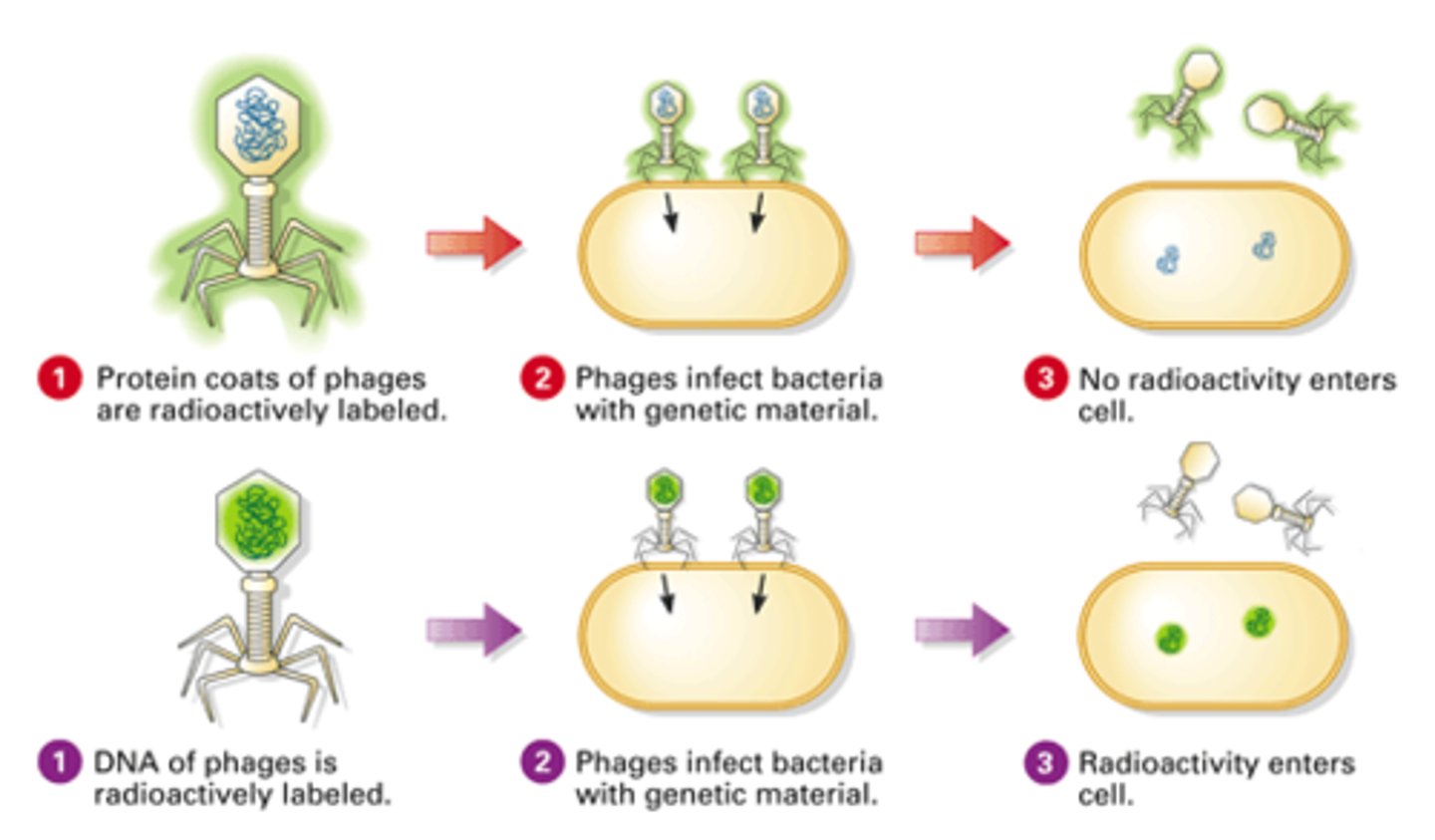
Explain how the results of the Hershey and Chase experiment supported the notion of nucleic acids as the genetic material.
AHL A1.2.14— Evidence from the Hershey–Chase experiment for DNA as the genetic material.
The molecule of heredity must be pasted from generation to generation. When Hershey and Chase demonstrated that radioactively tagged DNA is present across generations of bacteriophages and that radioactively tagged protein is not, they demonstrated that nucleic acids must be the genetic material.

Outline the use of radioisotopes as research tools.
AHL A1.2.14— Evidence from the Hershey–Chase experiment for DNA as the genetic material.
Hershey and Chase relied on radioactive isotopes of phosphorus and sulfur in their experiment to determine that DNA is the genetic material. Although they had been used on a small scale prior, after World War II the U.S. Atomic Energy Commission began mass-producing radioisotopes, sending shipments of radioactive materials to scientists.
Because they give off energy as they convert to a more stable form, the isotopes allow biologists to track molecules as they move through biological systems.
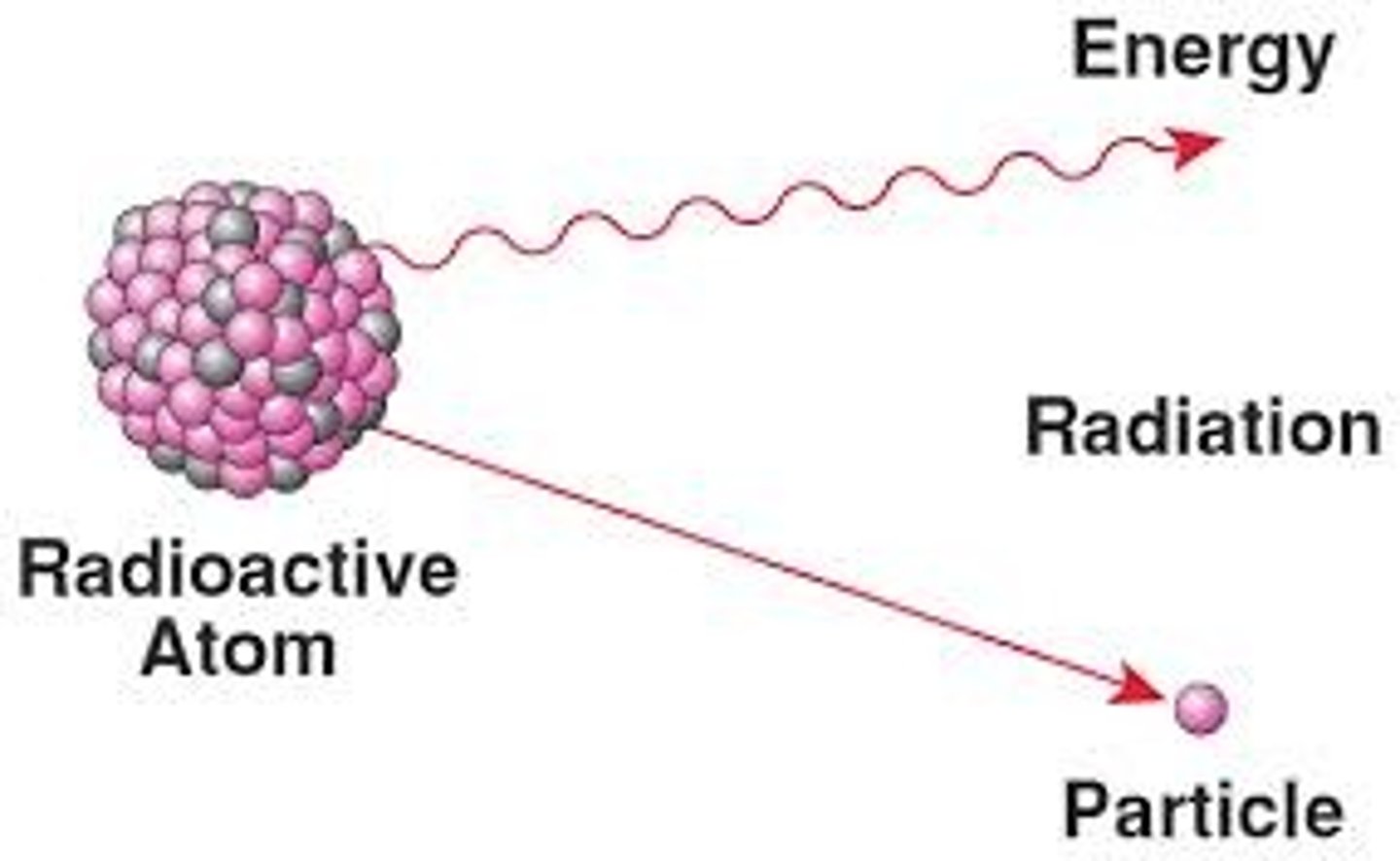
Describe the implications of Chargaff’s data that showed a 1:1 ratio of purine to pyrimidine in a sample of DNA.
AHL A1.2.15— Chargaff’s data on the relative amounts of pyrimidine and purine bases across diverse life forms.
Chargaff's research revealed the percentage of each base (A, T, C, G) found in different species DNA. He determined that there are equal numbers of A and T bases and G and C bases in a DNA sample, resulting in a 1:1 ratio of purines to pyrimidines in DNA.
Chargaff did not use inductive reasoning to then infer the pattern that A binds to T and C binds to G. The complementary base pairing rule was inferred by Watson and Crick.
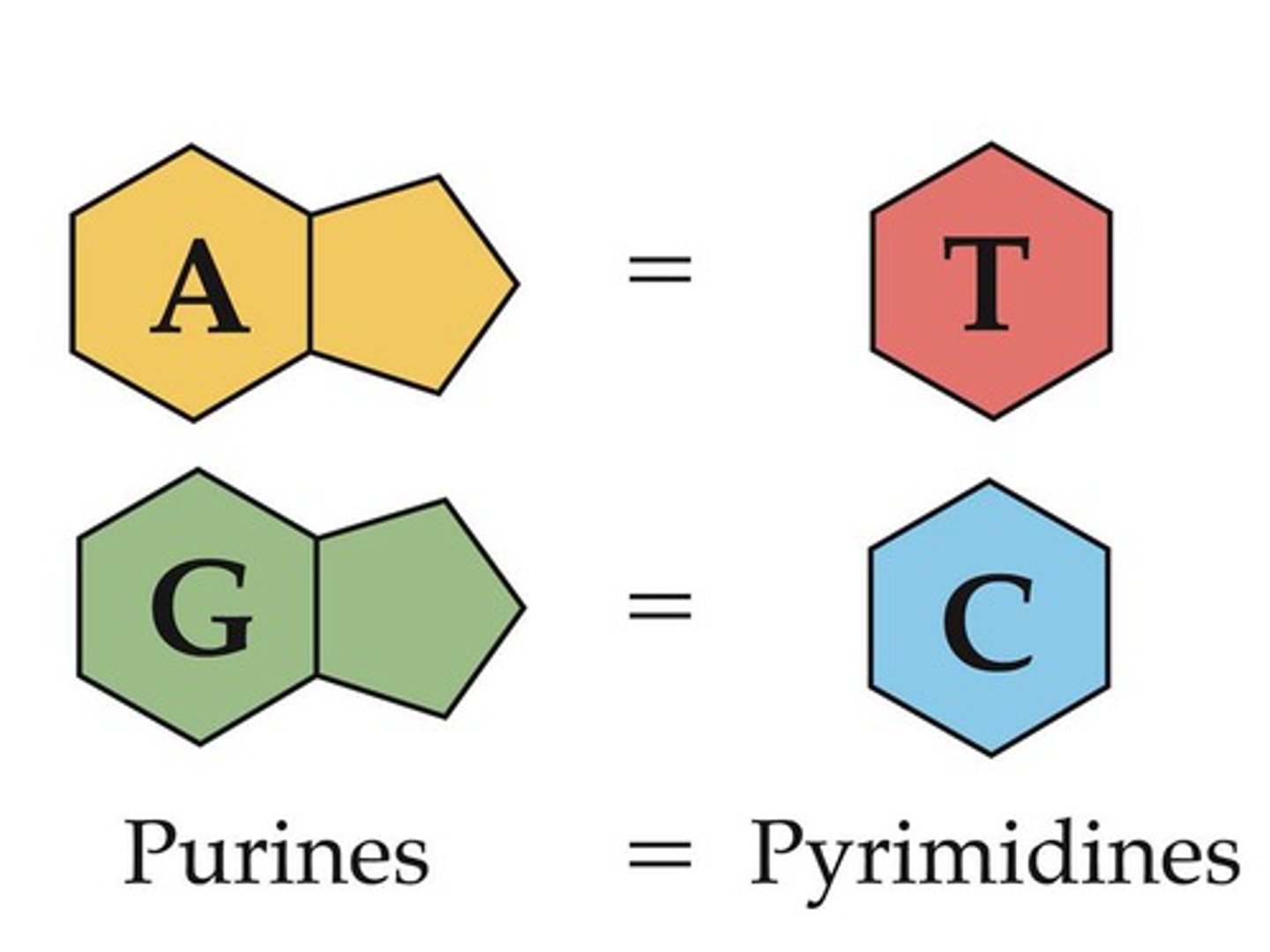
Explain the role of falsifiability in determining the structure and function of DNA.
AHL A1.2.15— Chargaff’s data on the relative amounts of pyrimidine and purine bases across diverse life forms.
To falsify means that a statement, theory or hypothesis is proven to be wrong.
Because he found that the amount of one base wasn't equal to the amount of the three other bases , Chargaff's data falsified the earlier hypothesis that DNA had a tetranucleotide structure. In this proposed model of DNA, the four bases occur in equal amounts in four strands arranged with the bases facing outward.
